#with its symbolism and cinematography and colours and story
Text
Yo Goldenheart and Nimona nation, do i ever have good news for you!
Do you like homoerotic betrayals?
Do you like lovers best friends being torn apart upon finding themselves on the opposite sides of a war? Where each is burdened with the responsibilities from their chosen role?

Do you like couples where one half represents the oppressive regime and the other half embodies EVERYTHING the said oppressive regime hates? Where the one half, acting as a tool of violence and subjugation for the oppressive regime, has to HUNT DOWN and ARREST the other half who has sworn to attack the oppressive regime head on?


Do you like couples with opposing colour schemes? Where one half embodies a particular element and the other half embodies a contrasting element? Do you like couples who are each other's foils? DO YOU LIKE COUPLES WHO ARE THEMATIC PARALLELS TO EACH OTHER??


Do you like a story that's rich in symbolism? Rife with metaphors? A movie that you can rewatch again and again and STILL discover new stuff to lose your mind over?

Do you like a story where love shines brighter than the sun? Where love conquers all the hurt, anger, grief, heartbreak, generational trauma and violence? Where love heals? Where the sheer power of love changes the entire course of the narrative? Where love rewrites history itself?

Do you like movies that make you feel THE ENTIRE SPECTRUM of human emotions within its runtime?

Do you like gorgeous, jaw dropping cinematography? Do you like highly stylized action sequences?


Do you like banger music and a soundtrack that slaps HARD? Do you like a wonderful song and dance interlude in a movie as it shifts into the next act?

Do you like a character who is just the sweetest and the best and deserves everything that is good in the world and has BIG BROWN MASSIVE ADORABLE DOE EYES? And then proceeds to go through the literal WORST TIME ever?


Of course, you do! You like Nimona!
And ho boy, are you gonna LOVE RRR. Because this movie has got ALL of that and then some more. It's an epic, it's a war movie, it's a love story, it's highly symbolical, it's going to take your heart and rip it into two. And you will thank it for that.
Hmm, Enigma. But where can I watch it? 🤔
It's available on Netflix but only as the dubbed Hindi version. It's pretty good for a dub as the actors dubbed their characters themselves and the director oversaw the translation but! But! Listen! There is a magic in the original Telugu version and if you want to experience it, then thank @charcubed for this post where you can download the original Telugu version in crisp HD with English subtitles FOR FREE
There is a third option. You can stream it for free in Einthusan here. However, the quality of the Einthusan stream is not good, and if there is one movie that DESERVES to be watched in crisp HD quality? Trust me, it's RRR
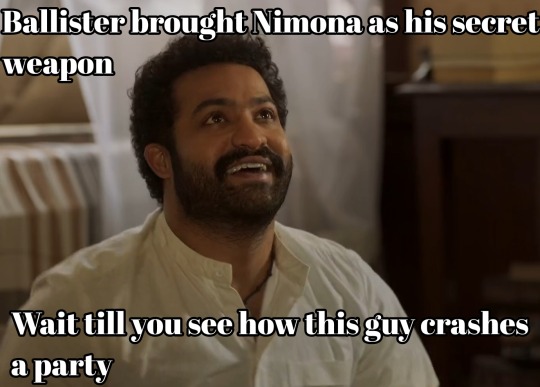
So, what are you waiting for? Go watch it, RIGHT NOW. Seriously
#nimona#rrr#rise roar revolt#goldenheart#rambheem#ballister boldheart#ambrosius goldenloin#rama raju#alluri sitarama raju#komuram bheem#komaram bheem#ballister x ambrosius#bheem x ram#original post#not incorrect quotes#desi#desiblr#desi tumblr#desi tag#india#riz ahmed#eugene lee yang#ram charan#nt rama rao jr#ram x bheem#dosti#naatu naatu#ambrosius x ballister#nd stevenson#nimona movie
131 notes
·
View notes
Text
I was tagged by my buddy @phoenixfangs so lets goooo
Are you named after anyone?
I've heard this story a buncha times so I'm pretty sure my mom got my birth name from a singer. She heard it on tv and liked it a lot, back then it wasn't a very common name in my country.
My names as of now are 50/50, Tom didn't come from anyone but Teddie was 100% something I picked up from Teddie p4, hahah.
When was the last time you cried?
Last Sunday when I rewatched ep 11 of Bucchigiri. especially during the part where Zabu got the absolute shit beaten out of him. Finn came home right after that and doesn't understand that one of the big points of media is to reach you emotionally, so he thought it was weird that I was crying.
Do you have kids?
Nah, but I'd like to some day, if fate allows it.
Do you use sarcasm a lot?
Not nearly as much as I used to, because most of my friends are autistic and don't get it most of the time, so I just end up upsetting them whenever I do use it.
Being sincere is much more fun anyways.
What sports do you play?
None, but I would love to swim or ice skate (or, hell, do some skiing). Neither are really possible for me atm, unfortunately (do you have any idea how expensive skiing is btw. it's crazy).
When I was a kid I did gymnastics and streetdance, I also played tennis briefly as a teen, but had to quit due to a lack of people in my age group playing at that club.
What’s the first thing you notice about people?
I usually take note of how someone dresses and does their hair. Ever notice how dull most people's clothes are? I like seeing styles that stand out.
What’s your eye colour?
Brown, it's not a particularly dark shade, but I wouldn't call it hazel (my dad has hazel eyes though).
Scary movies or happy endings?
This ones a little... vague? But I guess if I had to choose... I wouldn't. I don't care about genre or what type of emotional impact it has, as long as it's coherent and entertaining in its own right. (That doesn't mean I don't care about quality btw. I literally just. watch anything and judge it for what it is.)
Any special talents?
I'm a boss at packing in groceries quickly and efficiently. Not a talent that everyone possesses, I've learned (sorry Minke <3).
Where were you born?
Netherlands babeyyy ✌ North-Holland to be a bit more precise. I lived next to a dyke (not that kind) so I got the real under-sea-level experience. I still live around the area but not in my hometown anymore.
What are your hobbies?
Drawing, (writing?), translation and the nuances that come with it, watching movies, tv shows, animes, cartoons, playing video games, reading books, comics and manga. (and then talking about cinematography, parallels, themes, symbolism and the likes)
I also collect soda cans (+ the occasional glass bottle), candy packaging, and anime figurines + other merch.
Do you have any pets?
My little baby Jody (dog) who I've had since I was 7 years old! She's about to have her sweet 16 on the 23rd (that's in 2 weeks!) she's getting blind and deaf as hell but she's still lively and sweet as ever <3
And my sweet Tiger of course, who's of undetermined age (around 8/9 the vet said) and currently living with my good friend Minke and their 2 other cats (he does not like them) and dog (he is ok with her). He's not with me rn because my mom's bf is allergic, unfortunately.
How tall are you?
1 meter 59. that single centimeter haunts me. I would've also preferred an additional 10 as well.
Favourite subject in school?
Art history used to my favourite in high school, and when I was in film school for a brief period I loved film history. I just love anything pertaining to the arts and it's history that involves analysing and comparing it to other time periods, really.
Dream job?
I wanna be someone's househusband and make a buncha weird art on the side. Not kidding btw.
But if I had to choose a more conventional dream job... it had to be something in the creative or design industry, otherwise I'll probably die of unhappiness.
tageroonie @kuwupikaa @sunflowermews @xrd @isleofair @spunktrumpetsasara and uhhh other mutuals who feel inclined to do this 👉👈
#thanks for the tag buddy appreciate it mwuah#you're right these are fun to do. but it doesnt happen a lot anymore. at least not in our circles it seems#tag meme#tedpost#also i type. really weird.#i tend to switch to using very formal speech <like this#but i also use abbreviations and more casual speech? in the same paragraph?#idk man it might be because im reading richard again.
5 notes
·
View notes
Text
Black Adam talk dump
The last time a DC film made me this emotional over its cinematography was Wonder Woman (like that entire history scene in the beginning, whoosh my art brain was happy). So I was super stoked that Black Adam evoked the same feelings again and I just love, love that DC’s art team keep doing throwbacks to classical paintings in their storyboards and colour keys. Thor: Ragnarok managed to achieve the same effect (a friend who worked on the production confirmed that was the intention) and I think its a really great way especially with superhero films pertaining to godlike heroes to create an epic atmosphere.
The soundtrack helped too, I thought especially with the techno tracks it might have been by Junkie XL but Lorne Balfe is a favourite too so my auditory senses were also very well fed. There are things I could say about the writing and hearing that it was rewritten multiple times kind of summed up everything that is wrong about the script.
However I have to give kudos to whoever did the final edit for release because they actually managed something rather coherent out of a film that very obviously felt like it had multiple voices directing it. Especially with the show and tell aspect, I read somewhere that one of the trailers contained a spoiler because back when that trailer was released that version of the film didn’t view that scene as a spoiler. So the fact that they still manage to pull off that twist despite the mess caused by higher ups was very impressive of the editing team.
Spoilers of more things I want to talk about:
Wow finding out that the statue of the champion was actually Hurut was heartbreaking especially since it was destroyed near the end of the movie; the statue had to be the only realistic image Teth-Adam had of his son since there don’t seem to be any other depictions of him from back then.
I think one of the cities was named after his wife? Again another ouch now that he had to live in the modern world without her while seeing the name everyday.
There is something to be said about a world where gods walk among mortals and how faith can be both figurative and real- I love the way that question was interposed in the scene where Teth-Adam was floating seemingly drowned and Amon calling for him because you can view it as either the power of faith of the Khandaqi people woke him up or he woke himself up with his own power and the faith was just symbolic. Other people might interpret that differently but I view it as rather ambiguous because I preferred it that way.
It’s quite obvious I’ve never read the comics and knew nothing of Black Adam beyond reading his wiki but I do enjoy how the writers changed his story in this film to be a critique of neocolonialism especially in context of the superhero genre. There is a lot I can talk about this topic and while I think the dialogue in regards to that is rather clunky it can’t be helped especially since a more nuance take on the topic might go over people’s heads.
The hint that Black Adam might be the villain in the next DC film also made this commentary really interesting, because I’ll be honest throughout the film I find it very hard to sympathise with the Justice Society. Given the clunky script I’m not sure if this was intentional even if it felt like it is for narrative purposes, because I know from a genre convention perspective we’re not supposed to view superheroes as an imposition of western authority but this film seem to be pushing that boundary for story purposes. Therefore it’ll be really interesting to see how DC will handle Black Adam’s character in future films especially if he’s hinted to be the antagonist against Superman. I’m aware of the shift in his character from villain to antihero in modern comics, but from what I read its more of a “this guy will punch Superman for plot purposes but will join forces with him to prevent the destruction of the world”, and less of “this guy will punch Superman to prevent him from carrying out western political agenda in this fictional Middle-east coded country”. So while the political commentary in Black Adam was an interesting direction for a superhero film to take (though I’m sure not unique) I do wonder how far it can be taken in context of the greater Hollywood climate for future films. (This is where fanfics can come into play but I’m sad that there are maybe only 9 fics on ao3 and none of them feature Black Adam ;u;)
#black adam 2022 spoilers#black adam 2022#black adam#teth adam#i'm really shocked a super hero film in 2022 made me feel this way#especially with superhero film fatigue cuz marvel#but black adam was really refreshing#its not amazing or the best#but it was really good and worth a watch from me#also it goes without saying these are all my opinions and not an imposition on anyone else's views
55 notes
·
View notes
Text
Asteroid City (2023) Review

Wow, even for Wes Anderson this is a stacked cast! Might as well just advertise this as Asteroid City - starring all of Hollywood!
Plot: World-changing events spectacularly disrupt the itinerary of a Junior Stargazer/Space Cadet convention in an American desert town circa 1955.
Like or hate him, it is hard not to at the very least respect Wes Anderson and his directorial style, as he’s basically achieved his own genre at this point. You hear a movie described as ‘Wes Anderson-esque’ and you are guaranteed to expect beguiling symmetrical shots, bright vintage coloured flair, use of stop-motion animation and postmodern symbolism, all the while featuring a vast array of A-list actors appearing in either awkward or over-confident fast-talking caricatures. There’s an interesting article on Curzon detailing what a Wes Anderson style entails, and it is a very interesting read. You can find it on the following link: https://www.curzon.com/journal/unpacking-wes-anderson-s-cinematic-style/
So with Asteroid City you can already anticipate these Wes Andersonisms. The question is how strongly the style takes over the substance, and also if this is befit to Anderson’s stronger outings like Fantastic Mr Fox and The Grand Budapest Hotel, or does it lean more into the weaker aimless results of Isle of Dogs and The French Dispatch. Ironically those latter two films were the most recent of Anderson releases, so he could do with a hit now to reinstate his original success. Well, is it?
This may be the most Wes Anderson movie to ever Wes Anderson. It’s so Wes Anderson that you at the end feel like you have took a bath in the waters made out of Wes Anderson’s brain and are now overfilled with Wes Anderson syndrome. Went I walked out of the cinema, for a good minute or two everything around me looked over symmetrical, and colours popped. The latter effect I feel will also be a symptom when I watch the Barbie movie later this month, only then I’ll be seeing all pink. Look, visually this movie looks gorgeous, from the costumes to set pieces everything looks great, and Anderson evidently has a lot fun showcasing his visual craft. Speaking of the set, the Asteroid City itself is brought to life practically with Anderson and his production team literally building the set, and from the opening sequence the cinematography relishes in showing every little detail, every nook and cranny of this city, or more so town as for a city...well, it’s the tiniest city ever. Barely even a village. Nonetheless, it’s very well realised but at the same time this city manages to look very cartoony and unreal, however that’s not a detriment as this brings us smoothly to our next point...
Asteroid City makes the intriguing choice of providing a narrative meaning to Wes Anderson’s style. In most his movies like The Life Aquatic and The Darjeeling Limited we as an audience are simply thrown into the Wes Anderson landscape and simply made to accept his eye candy of a world. Nothing wrong with that, if ever a movie directed itself to the idea of escapism then it’d be a Wes Anderson flick. However Asteroid City goes a step beyond that by presenting this movie as if it were a stage performances, that is intercut with black-and-white segments of Bryan Cranston narrating how the writer (Edward Norton) is writing his final play, and how the actors bring it to life in the shape of Asteroid City. From the get-go Anderson underlines that Asteroid City is not a real place nor are its inhabitants or visitors, but that they are all performing a theatrical piece. A theatre stage and Anderson’s style do share a lot in common so this aspect worked really well and in fact this was one of the lesser pretentious elements of this film.
That being said, I also do think that in this case Anderson has gone more style over substance, as he was evidently so focused with creating a visual feast, that he somewhat forgot to have a decent story and have characters of any substance. Think of this as Anderson’s fine dining experience. The presentation is immaculate, the look of what’s on the plate is exquisite. But the portions are miniscule. You will receive a couple of delicious bites, but overall will be left unsatisfied and will most likely head to the nearby fast-food joint and grab a semi-decent burger and some fries to full up that stomach of yours. So with Asteroid City, there are a few delightfully splendid moments and ideas (for me personally an early sequence involving Matt Dillon’s repairman fixing up a car with this one tiny bolt was fittingly amusing), and for Anderson’s first venture into sci-fi territory the alien aspect was handled well enough, but overall I found myself heavily disengaged with the proceedings. It was a lot of ado about nothing, with moments happening just because, and one could argue that is simply the Anderson way, but it didn’t appeal to my personal tastes. Also most of the jokes didn’t land. The movie tries its hardest to be quirky light-hearted fun, but rarely did I even chuckle or smirk if that.
The cast - I mean, what a cast! Anybody who’s anybody is in this movie. Everyone fits really nicely into the caricatures Anderson gives them, however a lot of them are left with hardly anything to do, with the likes of Liev Schreiber, Tilda Swinton, Hong Chau and Willem Dafoe suffering most. I did enjoy Tom Hanks though as the more level-headed grounded of the lot, and Jason Schwartzman is continuing his solid summer streak after Across the Spider-Verse as a father who’s struggling to reveal to his children about their mother’s death, as well as supporting his son in the space program competition. Him and the son played by Jake Ryan make for a solid duo. Scarlett Johansson delivers Anderson’s line with style and eloquence bequest of his style, and Steve Carell is comically humorous as a motel owner who glimmers with positivity. Jeffrey Wright does a fun monologue, Adrien Brody provides frenetic quips as an auteur director (may or not be inspired by Anderson himself) and Jeff Goldblum cameos as an alien. All is well on the casting front, though if you’re looking forward to an ensemble piece where everyone gets their share, most appearances here are but fleeting cameos.
If you are a fan of Wes Anderson you will find enjoyment in Asteroid City, however I myself prefer a little more substance and meaning in the films I watch, and also the comedy didn’t land nor did I care much for what was happening. As I said, presentation is of a fine-dining level, but I will now head to get a McDonalds to settle my hunger.
Overall score: 5/10

#asteroid city#wes anderson#2023#2023 in film#2023 films#asteroid city review#movie#film#movie reviews#film reviews#cinema#comedy#drama#romance#science fiction#aliens#tom hanks#jason schwartzman#scarlett johansson#jeffrey wright#steve carell#edward norton#bryan cranston#adrien brody#tilda swinton#liev schreiber#maya hawke#matt dillon#jake ryan#rupert friend
6 notes
·
View notes
Note
So people are crazy for ITSAY and IPYTM. I seriously disliked them (hate is a step too far) mostly because I couldn't stand Teh's character, like, at all. If you enjoyed them, can you help me figure out what I'm missing and why everyone loved them so much??
Hello there. Thanks for the ask lovely.
I am in mid of watching IPTYM but finished ITSAY.
Just a couple of minutes of watching the first episode I realised its going to be good. It's not a run of the mill kind of BL you would usually expect. You could say it is a real life portrayal of queer coming of age story. It is hard hitting and ugly.
Now these kind of stories don't usually make for rewatches and for the same reason might not appeal to everyone.
The USP of this BL( I would not call it a BL actually, it comes under thought provoking media more than anything else) is its characters and their actual real life struggles. Nothing is sugar coated in this one.
So If you didn't like Teh's character, then I can see why you didn't like it. Because the story is essentially about Teh and Oh-Aew growing up and how it impacts the other.
Teh usually is indecisive but when he takes decisions they are spectacularly wrong. But I think the story does a good job of showing the consequences of his decisions.
I might sound repetitive but believe it or not it is how it happens in real life. Teh and Oh-Aew come from different type of families, that also has an impact on how they are or what they do. Teh's mother is traditional, she heavily depends on the concept of the man of the family. This could have impacted how Teh sees accepting himself as queer would not be manly enough for his mother.
I have seen internalised homophobia in real life and let's just say it's not pretty. Loving a person who does not accept themselves (queer or not) is just a lost cause and it's depicted so beautifully through Oh-Aew.
For me I don't mind complex characters(that's a lie I actually love them) and Teh is extremely complex but quite sensitive. And that's where he comes of as not caring or selfish may be. He is fighting his internal daemons. For whole life he is compared to his elder brother (who is so good by the way) and when he sees his best friend also becoming a competition for him it was natural how he reacted. But all this is not overly dramatic or sensational, it's so true to how it would happen in my or your family. Most of Teh's insecurities stem from the comparison to his elder brother, but despite that he is the one who he talks to. Which was such a good storytelling choice.
I think you have to be open to the concept that, not always the lead characters would be text book perfect, that's not how it works in real life. In the real world people are scared, selfish, stupid, sometimes dry. Not everyone is courageous enough to be themselves and that's all right.
What matters is the journey and whether they learn from it.
Other than story itself, ITSAY delivers on all other departments as well. The cinematography is absolute best I have ever seen. The actor duo has depths. Editing and back ground music stand out. I loved the little call backs of various things like the coconut smell or the back itching or the bra colour, absolutely genius script. There is lots of symbolism going on as well. Like the underwater scene, or the tutoring etc.
May be this is the reason it's favourite for many people. But then it also comes down to your personal preferences and what you like to watch. Though I liked it, I don't think I would rewatch it. Atleast not in near future. After I finished ITSAY I didn't immediately start IPYTM because I knew it's gonna be similar and more realistic as they step in the real world as a couple. For me it depends on my mood what I watch at that time.
Currently I don't want to see people cry so IPYTM is on hold lolzz.
So yeah I can totally see why you don't like it or not particularly a fan of it.
Anyways this became too long sorry for that. But hope this answers your question somewhat.
Let me know what kind of BLs you like? What are you enjoying currently?
6 notes
·
View notes
Text
26/06/2024
I was sick today and couldn't attend the lectures. I will cover up the things I missed.
-----------------------------------------------------------------------------
So today, Dinendri has explained about the explained about the assignment and requested to come up with 6 different narrative ideas for the opening scene.
She also has tasked us with researching some topics. The topics we are supposed to research are,
Director's style.
The plot line.
Symbolism in the film.
Secondary characters and their purpose.
Journey of the main character.
Colour Palette used in the film.
Location and the setup.
** The overall of storyline should remain the same while the recreated opening scene should be connected to the second scene.
-----------------------------------------------------------------------------
01.Garth Davis's directing style.
Garth Davis's direction in Lion really focuses on using visuals and emotions to tell the story. He uses different techniques to make the audience feel connected to the characters and the world of the movie.
Key elements of his style -
Visual Storytelling
Immersive Cinematography: Davis worked closely with cinematographers to create visually striking worlds. The difference between the lively, bustling India and the peaceful, structured Australia is a perfect example.
Colour Palette: The movie's colour palette is picked out with a lot of thought to make the mood and vibe of each scene better. The cozy, natural colours of India stand out against the calmer, more muted colours of Australia.
Sound Design: The director has focused on sound design, and it has helped to make the story more emotional and interesting with all the different sounds.
Emotional Depth
Character-Driven Narrative: The movie delves into the characters, especially Saroo and his family's emotional experiences. Davis has given the actors plenty of room to showcase their acting skills.
Subtlety: Instead of using obvious emotional tricks, The director has chosen a more understated method, letting the viewers form a deeper connection with the characters.
Pacing: The pace of the movie is perfectly timed to increase suspense and then let it go, making a strong emotional effect.
Other Notable Techniques
Non-Linear Storytelling: Davis has used a non-linear storytelling approach to delve into the intricacies of Saroo's journey.
Use of Silence: Davis has adeptly utilized periods of quiet to establish tension and give the audience the opportunity to ponder the emotions of the characters.
Garth Davis's direction in Lion is known for its focus on visual storytelling, emotional depth, and a subtle yet impactful filmmaking approach. His talent for crafting immersive worlds and resonating with the viewers emotionally has played a key role in the film's lasting appeal.
youtube
------------------------------------------------------------------------------
02. The plot line.
The movie commences in India, depicting the modest life of young Saroo alongside his mother, brother, and his sister. One night, a twist of fate leads him to inadvertently board a train alone, waking up hundreds of kilometers away in Calcutta. Lost and terrified, he navigates the harsh streets, encountering unimaginable challenges before eventually finding himself in an orphanage. After that, Saroo is adopted by an Australian couple and raised in a nurturing environment. As he grows up, despite his content life, he is plagued by memories of his childhood and a deep yearning to reconnect with his biological family. In his adulthood, equipped with cutting-edge technology, Saroo embarks on a relentless journey to locate his long-lost home using Google Earth. Fuelled by hope and unwavering determination, he gradually unravels the enigmas of his past, culminating in a poignant reunion.
------------------------------------------------------------------------------
03. Symbolism in the film.
Jalebi: Symbolizes the pleasure and privilege that they dream of as poor children.
Butterflies: Symbolizes memories and identity.
The Train: Represents both connection and separation. It brings Saroo to a new life but also tears him away from his family.
The City of Calcutta: Symbolizes chaos, poverty, and the harsh realities of life for many.
Soda: Represents relief.
Australia: Represents a world of opportunity, stability, and a different kind of family.
Google Earth: A symbol of modern technology's power to connect people and overcome geographical barriers.
------------------------------------------------------------------------------
04. Secondary characters and their purpose.
Guddu: Saroo's older brother, serves as a protective figure and represents the bond of sibling love. His disappearance is a catalyst for the film's plot and highlights the harsh realities of life in India.
Kamla: Saroo's mother, embodies unconditional love and resilience. Her character emphasizes the strength of maternal bonds and the devastating impact of losing a child.
Sue and John Brierley: Saroo's adoptive parents symbolize love, nurture, and the power of family. Their characters highlight the contrast between Saroo's impoverished upbringing and his privileged life in Australia.
Mantosh: Saroo's adopted brother, provides a contrasting perspective on adoption and the challenges of identity.
Lucy: Saroo Brierley's girlfriend represents Saroo's life in Australia, a world of comfort, stability, and opportunity. This contrasts starkly with his impoverished childhood in India.
Noor and Ram: Pivotal characters in the early, harrowing part of Lion. Their roles serve to highlight the dangers and exploitation faced by vulnerable children in India.
The social worker: Represents the system that enables international adoption and the complexities involved in such processes.
Purpose of Secondary Characters:
To contrast and highlight Saroo's journey: The characters from India and Australia offer stark contrasts in lifestyle, culture, and opportunities, emphasizing Saroo's extraordinary journey.
To deepen the emotional impact: The relationships between Saroo and these characters evoke a range of emotions, from love and loss to hope and resilience.
To provide narrative structure: These characters play essential roles in propelling the story forward and developing the plot.
------------------------------------------------------------------------------
05. Journey of the main character.
Saroo Brierley's experience in the film Lion delves deeply into themes of loss, identity, and the lasting impact of human relationships.
Originally from a small village in India, his peaceful upbringing is abruptly disrupted when he boards a train by himself and becomes lost in the vast city of Calcutta. Confronted with the harsh realities of life on the streets, he is eventually rescued and placed in an orphanage. After being adopted by an Australian couple, Saroo creates a new life filled with love and opportunities. However, the lingering memories of his past continue to tug at his heart. Motivated by unwavering determination, he sets out on a relentless journey to locate his biological family, using Google Earth to piece together the fragments of his lost childhood.
His story serves as a testament to the human spirit's capacity to overcome hardship and the enduring strength of familial connections.
------------------------------------------------------------------------------
06. Colour Palette used in the film.
The film "Lion" skilfully employs colour to distinguish between the contrasting settings of India and Australia.
Indian Palette:
Warm, earthy tones: Predominantly browns, oranges, and yellows are used to depict the dusty, rural landscape of India.
Vibrant hues: Despite the overall earthy tone, pops of vibrant colours like red and green are used to highlight the bustling, chaotic nature of Indian cities.
Australian Palette:
Cool, muted tones: Blues, greens, and greys dominate the Australian scenes, reflecting the calm and ordered nature of the country.
Subdued colours: The palette is generally more subdued to contrast with the vibrant colours of India.
------------------------------------------------------------------------------
07. Location and the Setup.
Locations-
India
The movie's storyline commences in rural India, particularly in the state of Madhya Pradesh. This backdrop sets the stage for the sharp disparities between the impoverished, yet culturally rich existence Saroo encounters and the wealthy, contemporary society he ultimately becomes a part of.
Australia
The latter part of the movie transitions to Australia, where Saroo is adopted and raised. This change in surroundings emphasizes the cultural and societal disparities that influence Saroo's development and experiences.
The Setup -
The movie begins by introducing the audience to young Saroo in his Indian village, showcasing his close-knit family and simple way of life. Soon after, a significant event unfolds as Saroo gets separated from his family and is left to fend for himself on the streets of Calcutta. This sudden shift of circumstances paves the way for the subsequent events in the film, focusing on Saroo's survival, adaptation, and eventual quest to reconnect with his past.


(Tumblr is acting up and not letting me upload the links to the websites which I found information from. It won't let me save the post with the links. So I had to remove a few links. I will try again to upload the links later.)

0 notes
Text
The Navigator: A Medieval Odyssey (1988)

The Navigator: A Medieval Odyssey makes some bold choices with its cinematography and writing. It’s a very stylishly directed film. You'll find a permanent place for it in your memory, even if the ending sours the taste a bit.
During the Black Death in England, a remote Cumbrian village fears the plague that ravages every big city. Believing that the moon has something to do with the disease’s spread, the village elects a group of men to gather their best copper so they can cast it into a cross and place it on the steeple of “the biggest Church in all of Christendom”. They believe this will grant them special protection. Led by Connor (Bruce Lyons) and his young brother Griffin (Hamish McFarlane), whose visions will guide them into the unknown, the men begin their journey by going underground.
The film begins in black-and-white, which perfectly sets the mood. These people have no idea how diseases work, they’re perpetually frightened of a world they don’t understand and stuck in one of the worst periods of European history. Suddenly, we see colored images: Griffin’s dreams. There’s a torch falling down a seemingly endless hole. Is it a symbol or something they should expect to find as they gather the materials needed for their sacred offering? Griffin’s dreams tell them they need to go deeper and conveniently, they find a tunneling machine that allows them to do so. The camera zooms out. We see their clear path down, down, down. Where are they going? You can’t wait to find out.
The men eventually break through into a smooth-lined tunnel. There, the film switches to colour and although everything they see is alien to them, we recognize their destination. They’ve somehow landed in the late 20th century, in New Zealand. That was unexpected.
The way it shows these people as they really would be is honest and genuine. Don’t expect these men to meet up with some sassy teenager who will teach them about television, rollerblades and hot dogs. Most of what surrounds them they don’t pay much attention to because they never really grasp how far they’ve traveled. It’s just the biggest city they’ve ever seen with lots of lights everywhere and strange horseless chariots that move impossibly fast. They don’t have the time to explore because all they want to do is find the biggest church so they can melt their copper, stick a holy cross on its steeple and turn around. Meanwhile, Griffin’s visions hint at an incoming tragedy.
This is where I’m of two minds on this film. On the one hand, I admire the film for its realistic portrayal. These people are always frightened, perpetually confused and their fellowship is constantly on the brink of falling apart. On the other hand, those emotions are the entire film. There are no reprieves from the fear and the drama. It’s relentless and at 93 minutes, The Navigator: A Medieval Odyssey starts to become dull because it’s the same thing over and over. People are scared. People are confused. A vision from Griffin hints at death. People are scared. People are confused. Another glimpse at the same vision. People are scared...
I suspect the film’s ending will polarize audiences. Don’t get me wrong, it’s still a good picture but the conclusion is at once clever, and a cheat. There’s no way you can see it coming because the film deceives you. It left me with a bad taste in my mouth when combined with the overwhelmingly dour story. That might not be the case for everyone. This film is just quirky and weird enough that I could see it described as genius by some. I might feel differently about it on a second viewing, though honestly, I’m not sure what circumstances could push me to watch The Navigator: A Medieval Odyssey again. (June 17, 2022)

#The Navigator: A Medieval Odyssey#movies#films#movie reviews#film reviews#Vincent Ward#Geoff Chapple#Kely Lyons#Chris Haywood#Marshall Napier#Paul Livingston#Jay Laga'aia#1988 movies#1988 films
1 note
·
View note
Photo
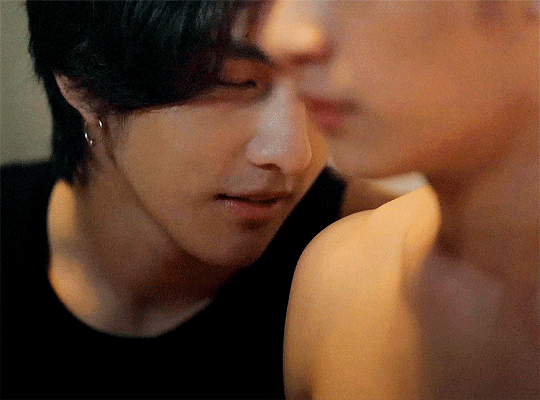




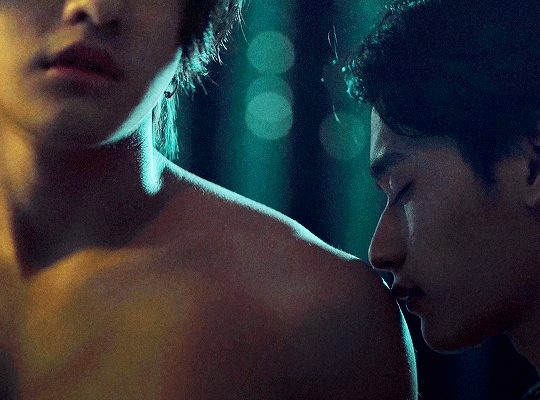
On Cloud Nine | Episode 3 & 6
#on cloud nine#on cloud nine the series#rossi nonthakorn#meen nattakrit#cloud9edit#thai bl#thai drama#bl drama#bl series#tdrama#my edits.#this show#this beautiful little show#with its symbolism and cinematography and colours and story#it quietly became one of my favourite productions of the year#i wonder what the budget here was but i think they did phenomenally#and i'm super glad they went against the grain and didn't rely on the usual tropes and overt storytelling#i really hope mind trio can continue like this (and make lots of money while doing it lmao)
103 notes
·
View notes
Note
Would love a Correct Take on Breaking Bad from you
ok here we go please feel free to throw tomatoes at me
“’What I want –what I need - is a choice’’ – when Walter enters the narrative he is already dead. His deadness foreshadows and unleashes a katabasis, literally ‘animating’ him. It’s the first of a series of symbolic oppositions that the story goes through in both a metanarrative sense and in an esoteric play of forces on a stage.
His choice to live is a realisation of both his liminality and a dire measure to enact a cathartic narrative – life is defined by death and his actions become more and more death-driven the more they become obsessively love-driven, as he burns his dreamstate self (the timid teacher) to achieve his Real self – the immortal Ubermensh, ‘’king of kings’’; to enact a grandiose myth of Becoming
Of course this must come to be through drugs. Drugs, as historically an instrument for transgression from ordinary reality to heightened consciousness, are in their genesis a shamanic attibute. Symbolically they’re the stuff of dreams, altered states of consciousness, unreality, visceral and intense experience of the Self, they mark the threshold between two worlds. Walter “I am awake” White ‘knows the chemistry’ and describes it as the study of ‘growth then decay then transformation’ – an esoteric view by anyone other than an alchemist - like him
Alchemy as a motif of transcension is reflected by the colour play of cinematography in the series - many video essays talk about BRBA’s storytelling through color; The Great Work of Alchemy is described as a series of 4 stages, represented by color/coloring – nigredo- a blackening, albedo - a whitening, citrinitas - a yellowing and rubedo, reddening or purpling. The dynamism of the narrative juxtaposes those colors constantly to signal a fluctuating transmutaion of the characters between stages of change, which is realised in a transformation in the very end, as the color scheme between ‘stage’ and characters turns into chiaroscuro. Now, alchemy is opaque as hell, but its popular core Thing is the transmutation of lead into gold as a metaphor for spiritual purification and ascension from a diseased ephemeral state to a perfect everlasting Being – summed up in Walt’s speech: he distinguishes chemistry from an empirical, positivist study of ‘matter’ and explicates it to a study of spiritual and metaphysical ‘transformation” [c.f: the ‘wire’ scene – the material is lead, and alchemy’s thing is to turn lead into gold - a transsubstantiation to elevate the soul into a heighteted mythic state.]
Now, Carl Jung was Obsessed with alchemy as a path to growth and as a symbolic system of mapping the psyche, which is where he derives his concept of ‘individuation’. He wrote about alchemy as a ‘symbolic process of coming into wholeness as a human being where opposites are brought into contact and inner and outer, spirit and matter are reunited in the hieros gamos or divine marriage’’. Jung posits that individuation is a business one undertakes in the ‘second part of life’ – the midlife crisis, as a ‘’’process of becoming conscious of parts of the Self that were not admitted into the persona in the first half of life[…] the ego begins to confront inner ‘’opposites’’’’ , the integration of the ‘shadow self’, a process of transcending ordinary social life and expectation and entering a philosophical mode of living.
Walt’s choice is to enact this process – his alchemical view of life gains a material exression through his ‘product’, referred to in the show as an almost mystical substance, distinguished by its color /blue as a hermetic symbol of the final stage before catharsis/. His meth is a transsubstantiation of lead into crystal and from the crystal’s distribution into ‘gold’. /’there is gold in the streets just waiting for someone to come and scoop it up’/ - its both transgressive bc it’s a psychic catalyst and a base form of ‘gold’. Being his symbolic opposite, Jesse is the vital component of Walts individuation – he’s a reagent for the transsubstantiation of meth into gold /’you know the business and I know the chemistry’/. And Walts “corruption arc” is the integration of his shadow self - which becomes possible mostly through his affair with Jesse - love is the biggest transsubstantiator, and in a tragic narrative, dark, abusive love is even better >:))
Which brings me to the core of the show – their hieros gamos, symbolic marriage which transfers Walts individuation to Jesse. Their relationship has paternalistic motifs, Walt substituting his children for Jesse and Jesse acting as immaturely in the beginning, yet he also uses Jesse as a wife surrogate (an abuse of power analogous to covert incest, and several characters point that out, most notably Mike in his speech-thesis moment of misattribution, falsely identifying Walt as a domestic victim and foreshadowing Jesse as the battered wife)
To me their psychosexual entanglement is very real and it’s the crux of people’s misunderstanding. The audience averts their gaze from it – some are disgusted by their ‘shipping’ – and while it’s not a thing to ‘ship’, they see only a father-son dynamic, which fragments the story’s internal logic. Some ‘ship’ it facetiously, picking up on the part of that dynamic which makes the first group’s denial so aggressive. they also miss the complexity by reducing it to an abusive relationship (it is that, yet that view is simplistic)
Because the show is a tragedy, their ‘divine marriage’ cannot be anything but profoundly violent and wounding. In its context Jesse could be seen as perversions of the dichotomy anima-animus- Jess the anima – intuitive and reactive, and Walt as animus - possessive dominating and abusive. It’s a dynamic that leads to both their deepest pits of suffering and their ‘deaths’ – Walter’s limbo-purgatory in the cabin and immortalisation at the centre of his lab(irynth, bc the minotaur myth is sacrificial myth) (and the story) - his chamber of transsubstantiation, and Jesse’s symbolic death in the cage /in an image of hellish medieval punishment/ and resurrection, when he breaks through the cages in the desert. The progression of Walts destructive love for Jesse is something like a Nero-Sporus situation, which is also why Skyler is framed like that /as seen by Walt/ – she’s in the way of Walt and Jesse’s ‘consummation’, she’s an obfuscation of Walt’s true desire, the redemptive mirage he clings to as he builds his monument for immortality. She names their baby Holy, as creation is holy – that baby is an image of salvation for Walt, as he descends lower and lower in his katabasis.
His relationship with Jesse is what drives that tragedy – his jealousy of clean cut mentors that contrast with his possessiveness, of the women Jesse ‘cheats’ on him with drives him and the narrative – Jesse is Walt’s in body and soul, his ‘partner’ – his other half, and he is not allowed to have anything but Walt /’’if there’s a hell we’re pretty much going there’’/ - Jesse ‘married’ Walter when their journey to the underworld begins and as per their ‘deal’ (50/50 partners. like in marriage. which is a deal of partnership), only death can do them part.
And as Walt can’t cease the chain reaction of violence he initiates and they enter into sacrificial crisis territory, where distinctions between everyone are lost and the cycle of destruction propagates: Walt needs blood to fuel his upward momentum; like Bob he has “the fury of his own momentum” and the ‘fire he’s started is very hard to put out’
The sacrificial crisis /Girard/ begins with an incorrect sacrifice and can only be stopped with a ‘correct’ one - a surrogate victim that would cleanse the community of evil and restore order. In the chapters leading to the denouement, Walt is rushing at breakneck speed to an explosion (he is ‘a time bomb tick tick’) - he’s running out of victims to sacrifice in the name of ‘keeping himself and Jesse’ alive That’s his predestined course /in a tragedy everything has already happened, blah blah/ and everyone is ‘around for the boom’: as Jesse spirals into an opheliac ‘madness’ (he’s a ‘rabid dog’ to be put down), he looks like the sacrificial victim most fit for Walts altar. But as long as Walt -Heisenberg- is alive, he can’t sacrifice Jesse - he is dependent on him for his life. I think BRBA is heavily influenced by Twin Peaks and vice versa later on (e. g. the Jesse/Laura paralells in brba and the new mexico test atomic explosion in ep 8 of The Return as the birth of al evil). Heisenberg is the father of evil in the story and is the shadow self that consumes Walt in his off the rails individuation journey: he starts a ‘fire’ of bloodshed and violence that can be put out only by closing the circle and sacrificing the creator to his own monstrous disembodied creation. What he does wrong - his hubris in thinking he is his own shaman. Kastaneda’s fictitious Don Juan, who feeds Karlos drugs in his initial journey into himself, says that one must traverse the land of dreams, the world beyond this world with a shaman-mentor as a guide - otherwise one will get lost and ‘die’, consumed by his shadow. Walter manufactures his drug-atomic bomb and it consumes him. And this might not be TP, but just like Bob, Walter is immortalised and Jesse, much like an inverted Laura, lived for Walter’s sins.
Anyway, their sacred acts of betrayal in the desert are elevated to myth, as emphasized by Shelley’s poem Ozymandias,. The supposed etymology of the word ‘alchemy’ as ‘the egyptian science’/’black earth/soil’ is in opposition to ‘red desert sand’ – their alchemical journey is enacted in the ‘alone and level sands’ of an endless barren wasteland, like a stage or a mirage – as if the characters almost acknowledge the limits of their own Being as trapped in a story. In the desert they die and reach eternity in their own ways, enacting the first in a triad of sacred acts – betrayal. In the desert again they enter a last commune of the two other sacraments of love – forgiveness and salvation – in that last moment after Walt kills every trojan so that [gunshot] and they share a last look. That katabasis happens because of their grief turned rage and is transcended by their rage turned grief.
In the final episode Walt comes to the desert to die, not knowing of Jesse’s suffering, presuming a betrayal /like Jesse’s some Delilah/ and gives him back life and closure as he himself dies at the centre of his ‘shattered visage’, a death that has haunted him from the beginning. Jesse’s Job-like suffering concludes in a triumph of transformation through his ‘marriage’ to Walter – the alchemist of human souls. Walter’s Faustian more than he is evil though, because he seeks redemption through confession, and “If we confess our sins, he is faithful and just and will forgive us our sins and purify us from all unrighteousness”. And he does offer Jesse to kill him. And Jesse as a figure of salvation is seen in refusing to (“then do it yourself”) - Christ is posited by modern thinkers to be the anti-sacrificial figure, exposing the mechanisms of scapegoating by fully abstaining from reciprocal violence; his sacrifice the one to end all sacrifices. Jesse staying alive and exiting the story is him both remaining eternally living and Walt - eternally dead - one last cyclical dichotomy, affirmative of forgiveness as a great sacrament.
Jesse i think could be the ‘traveller from an antique land’. As he exits the story, leaving Walter to die a monument and center to it in the belly of his lab(irynth*), he is the only carrier of its intimate truth - that mythic, archaic story of the man who grew so big he brushed against gods and imploded - a smear of ruins in a barren wasteland - that’s one consuming tale to carry! (In The Return, Laura is posited as an immanent being of light, contrasted with Judy’s atomic birth of evil; if Walter is eternal in the desert like Ozymandias or an atomic site, Jesse is eternal as a Traveller outside of evil => as light)
tl;dr BrBa is ti me an archetypal faustian tragedy that coalesces around an intensely spiritual, violently libidinal and destructive love story between Walt and Jesse. It investigates the transformativity of annihilation, hubris, vengeance and power, but also in that space - an ascension through profound suffering and sacrifice and forgiveness as a consequence of that love, that leads to either an individuation as rebirth and life or one as a last soaring fly in search of immortality. Everyone is a tragic hero and most of all Walter, who pursues his death to the bitter, grand and monumental end
Guess ill go kill myself now. Lastly, Anne Carson: ‘’myths are stories about people who become too big for their lives temporarily, so that they crash into other lives or brush against gods. In crisis their souls are visible.’’
#sorry guys for the twin peaks brainrot but ill take that to my grave#anyway#breaking bad#twin peaks#adjacent#i guess#walter white#jesse pinkman#kms after this btw
44 notes
·
View notes
Text
Rec List Request
A personalised list for @jammy-boy 🥰 could be of interest to others, so enjoy!
Basic requirements:
- just finished and loved SOTUS
- is Arthur/Merlin trash
- loves a twist or reversal of classic “power-dynamic”
- loves angst with happy ending
______________________________
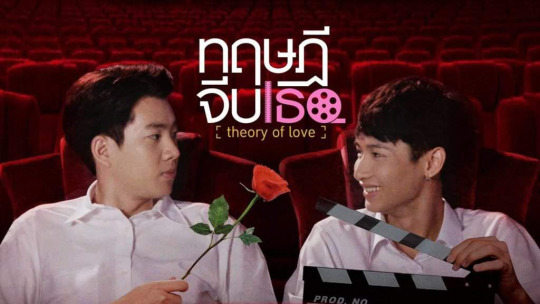
Theory of Love
Film student Third (Gun) has been secretly in love with his best friend Khai (Off) for three years, but Khai is straight, a massive player, and a total arsehole if we’re being honest. This starts painful, but then they start playing around with tropes and expectations and then it changes POV which just HITS so hard and completely changes your whole perception. You know the movie Flipped? It references that, and then does the flip - so good.
Knowing the level of pining, pain and angst that you love (plus your background in film studies) I feel like this is required viewing. Get out the tissues. But also, it’s still really funny and cute/dumb (cause gmmtv) and the production was excellent. Also, Off/Gun are PEAK natural chemistry and Gun is such an incredible actor that watching him cry or yell at someone is still preferable to other actors being happy.
Watch on YouTube HERE

He’s Coming To Me
Precious baby boi Singto plays Med, a ghost, who is is stuck in limbo for 20 years - until he meets a boy who can see him, Thun (my baby boi Ohm) who promises to help him figure out his unfinished business and cross over. And then they were roommates! And then they start falling in love and it’s ANGSTY because they know Med will have to leave one day. Ouch, my heart.
You will enjoy the mixture of domestic fluff and tragic angst in this. But don’t worry it has a happy ending (kind of, I think, from memory haha). Also, you will enjoy the fact that they can’t touch (cause, ghost) which is *chefs kiss* except for moments of heightened emotions when Thun’s powers become strong enough that he can touch Med (FUCK YES, THIS TROPE IS EVERYTHING)
After much whining from fans, they put it up on Youtube haha so watch HERE.

Until We Meet Again
ANNGST. RE.IN.CAR.NA.TION. ANGST. What else do you need to know?!?! Reincarnated soulmates trope?!!? HELLO!?!? It’s so beautiful. I’m still not over it. And yes it has a happy ending, it starts super sad, then ends up super fluffy and the romantic fluffy moments oh god it’s so romantic. I know you love like soft domestic food sharing etc - this show is ALL about the cooking.
The casting, the characterisation, the acting, the story, the music, even the friendship group and the side-couple, it’s perfection *chefs kiss* PERFECTION
Watch on youtube HERE

A Tale of A Thousand Stars
After the lovely volunteer teacher Torfun dies (RIP poor torfun) in a tragic accident, her heart is transplanted into selfish pretty rich boy Tian (played by the beautiful Mix). After learning of her selfless character, he feels guilt and shame for living (the angst is very real) and makes it his mission to complete her life’s wishes and follow in her footsteps.
As the new village volunteer teacher, he then falls in love with the very handsome and very shirtless chief Phupha (Earth), who lives to protect the trees, we stan an environmental man. Angst, fluff, complications, and many miscommunications ensue. I was tearing my hair out by the end of this show. Yes, it has a happy ending (eventually). Earth x Mix was a pairing we did not know we even wanted or needed until this show happened and now I cry every time I see a picture of them together. Every single time Phupha looks at Tian in this show I literally tear up. HE LOVES HIM SO MUUUUUCHHH *crying again*
Watch on youtube HERE
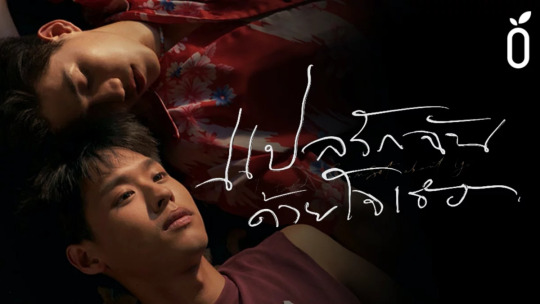
I Told Sunset About You
Childhood best-friends, turned enemies (for stupid kid reasons), to lovers. This is ANGSTY but so fucking beautiful it’s ridiculous. I wouldn’t even class this as “BL” because it doesn’t have any of the standard tropes, and there’s no silly sound-effects or innuendo jokes. This is like genuine lgbt+ indie-film realness. You can honestly just watch it for the cinematography and the music. The AESTHETIC of this show is what truly makes it special. The symbolism, the colours, this show said CINEMA. And the sexual tension is absolutely WILD. You will live for the angst (with a happy ending). And no, do not bother watching season 2, it’s perfect as a stand-alone mini-series. (I’m still upset).
Watch HERE
and now for some stand-out non-Thai series...

Where Your Eyes Linger
Korea has gotten on the BL train, and has now made a whole bunch of viki mini-series that are all cute but this one is right up your alley. This is VERY merthur. It’s literally servant/master, bodyguard/prince trope. But, I thought the characterisation was nicely thought out and wasn’t what I was expecting. The tension is palpable, the angst is juicy, and the soft kdrama vibes are cheesy and wonderful. Angst with a happy ending (of course).
Watch on VIKI

HIStory 3: Trapped
So the Taiwanese HIStory series has been around forever, and I love the whole series (History 2: Crossing The Line is my all time fav). But for youuuu, I think the most appropriate is Trapped. Police detective single-mindedly obsessed with a gang leader? Yes please. But whatever power-dynamic expectations you would have of a police/criminal couple are twisted and warped immediately! This series is so endearing, it’s mostly comedy/action, and whilst it has plenty of angst, mostly it’s just CUTE as fuck. Also the side couple are adorable too!
The whole History series is on Viki now yay!

The Untamed
Look, I KNOW 50 episodes of plot-heavy chinese historical fantasy is a lot. But there’s a reason this show was soooo popular. It only took me like 3 attempts and a whole ass “guide” pdf to figure out what the fuck was happening in the first ep cause its non-linear. But, if you are in the right mood (ie; sick, or in lockdown) and need something to get completely LOST in for like a week, then watch this haha. I know you couldn’t make it through Guardian, but maybe this one will hit the spot.
This has all the angsty character tropes you live for. And cause it’s censored, there’s no actual romance, so instead it’s just the best kind of UST, character driven, emotional soulmate angst. To summarise: Wei Wuxian is; adopted, a trouble-maker, impetuous, head-strong, fun-loving, has a martyr complex and wants to save everyone. Meanwhile, Lan Zhan is; lawful good to a fault, stoic, shy, and has a martyr complex about saving Wei Wuxian and Wei Wuxian ONLY. Now throw them into the middle of supernatural / political turmoil and see what happens. Well I’ll tell you what happens, Wei Wuxian becomes the “villain”, gets killed, and Lan Zhan spends 16 years looking for him. FUCKING KILL ME OKAY. (No, that’s not a spoiler it happens in the first episode haha)
Do NOT watch on Netflix the subs are trash. Watch on Youtube or Viki
~ ~ ~
This list may seem long but I was VERY reserved in my selection okay you have no idea how tiny this tip of the iceberg is 😂
Also, knowing your love of no-touching, tension, and angst. I would also briefly draw your attention so School 2013 in my bromance list which is the single most angsty show about friendship ever made.
Enjoy!
59 notes
·
View notes
Text
Holistic Analysis of ‘Volver’ by Pedro Almodovar
tw// mentions of child abuse, pedophilia, death, blood, and sharp objects
Conduct a holistic of the film Volver by Pedro Almodovar. Be sure to integrate terminologies and concepts from course discussions on both photography and film in your analysis. Cite all borrowed materials.
-------------------------------------------------------------------------------------------
‘Volver’ by Pedro Almodovar is a 2006 Spanish film set in Madrid, Spain as well as a small village in the La Mancha Region. Upon further research, it’s noted that La Mancha is where Almodovar grew up, which indicates that this film highlights the essence of his childhood.
‘Volver’, which is Spanish for ‘to come back,’ beautifully captures the importance of women’s lives and what comes of life after death. The film is compacted with stunning architecture, camera angles, color, music and sounds, and visual images that all fit into the film’s overall message.
-------------------------------------------------------------------------------------------
Composition: I have noticed throughout the film that Almodovar chose interesting and compelling camera angles for different situations. When people walk through big doors-- mostly with the windy village in La Mancha-- the camera would be at a one-point perspective. The center of the door would be the ‘vanishing point’ of the frame so that you’ll see the rest of the hallway that the characters will soon walk down. When Almodovar films the characters going up a flight of spiral staircases, he puts the camera on the ground facing upwards in the center to show the movement of the characters. When his characters are going down the set of stairs, he changes the angle so that the camera is at the top facing downwards. When characters are walking down or off onto the street, the camera tends to follow their movement in a single shot; either in front of the characters for more intense scenes and dialogue or on the side of the characters in a distance shot to move along the plot. I also noticed his choice of car scenes. He would usually show the red car driving down a dirt road of wind turbines in a distance shot. If there were people in the back seat, the camera would shoot from the front of the car, and if it’s only one person or two they would shoot their side profiles. I also noticed that certain frames had significance to the plot as an angle would be used for multiple shots; one with Raimunda cleaning the knife before and after the murder of Paco, and when Raimunda was standing by the tree by the river after burying Paco then later that same angle was used when Raimunda and Paula visited the same spot.
Visual Cues:
Color- The main color of the film-- as well as any Almodovar film-- is red. The color symbolizes death as well as womanhood-- the passion, empowerment, and life that goes with women. The film was full of bright colors, which is a usual touch that the director loves to add to all of his films. Almodovar chooses his color precisely by the setting, as he stated in his interview with Jennifer Merin about the film. He chose to use a lot of black and white because of the location and social environment of La Mancha. Those colors, he says, aren’t ones he typically uses but were the best choice for those certain parts of the film.
Gestalt Laws:
Proximity- The closeness between Raimunda and Paula throughout the entirety of the film shows that the two are related in some way. The fact that the two characters are inseparable and are seen living together, an individual can assume that they’re mother and daughter. Paco getting constantly pushed away and being distant from the characters symbolizes the dysfunctional relationship he had with Raimunda and Paula. When Sole ran away screaming from Irene upon first meeting her, one can assume that the relationship is unwanted by the forcible distance. However, we see about 20 minutes later, Sole allows Irene into her home and ends up sleeping next to her in the night. The sudden closeness indicates the love and comfortableness between a parent and child.
Common fate- The people of Madrid and La Mancha always kissed each other’s cheeks as a form of greeting. Raimunda and Irene both had their partners murdered for doing something taboo. Irene’s husband was having an affair and sexually abused and impregnated their daughter Raimunda. Raimunda’s partner, Paco, was stabbed by her daughter Paula for sexually assaulting her. Another common fate is that Raimunda and Paula were both sexually assaulted by their fathers/father figures.
Semiotic Signs and codes:
Indexical Sign- The abundance of people are dressed in minimal amounts of clothing which indicates that the weather must be quite warm. When the characters are in the La Mancha village, the character’s clothes and hair move rapidly indicating that the area has harsh winds.
Symbolic Sign- The use of red in the women’s clothing, on and in buildings, on the furniture, vehicles, and close-ups on vegetables and blood certainly doesn’t go unnoticed. However, an individual who notices may not understand its significance. Therefore, the color red is an example of a symbolic sign in this film. It emphasizes the meaning of life after death and the importance of womanhood. Another example of a symbolic sign is the song sung by Raimunda within the film. The title of the music is the same as the movie’s title, ‘Volver’. The song is about the need for one’s life to come back, especially a mother’s, in order to move forward in life, which is an addition to the film’s message. One final example is at the very beginning of the film. The women of the La Mancha village are seen cleaning off the gravestones in the local cemetery. The way the women talked with one another made the audience indicated that this was a common practice. This scene set up the meaning of life beyond death and womanhood because only women were standing over the dead.
Purpose of the Work: A main purpose of the work was for the director to pay homage to his childhood as the movie filmed in the place he grew up and the characters were similar to the women who raised him.
-------------------------------------------------------------------------------------------
Personal Perspective:
As usual, when films start, I need to take some time to get into it. This is the same with any kind of story, even with books. But, unlike books, I can stay focused and entertained by good cinematography. The Spanish film ‘Volver’ did just that for me. The stunning single-point shots and frames kept me wanting more. I completely adored the close-up shots of characters doing simple tasks. For example, when Raimunda was putting away Tupperware, washing the dishes, and grabbing paper towels-- just to name a few-- I absolutely adored how they were shot. When the plot began to thicken, however, it was more than just the cinematography that left me breathless. The acting was incredible that I was convinced I was watching someone else’s life right before my eyes. There were many surprises that I didn’t see coming that left me on the edge of my seat the whole time. When the film ended, I had felt satisfied and unsatisfied. I wanted to know more of the story, it felt like the conclusion was only starting when the credits began to roll. But, at the same time, I was okay with how it ended because I can make up my own conclusions about how I feel the story will continue. I really enjoyed how the visuals throughout the whole film were chosen carefully to match the overall message.
Cultural Perspective:
Almodovar uses a lot of past and present aspects of the Spanish culture in his films. As he grew up in Spain, it’s something he knows well and feels most inspired from. The director is obsessed with the media of Spanish culture-- such as telenovelas, magazine stories, infomercials. Almodovar adds Spanish media to his films quite often. For example, in ‘Volver,’ he uses the idea of a film-within-a-film aspect near the end of the movie. Another example is when Paco was watching soccer on the television in the earlier shots of the film. Almodovar claims that the brightness and intenseness of the colors match the drama that Spanish films have, which is why he tends to this culture more to satisfy his creativity. A quote from a 2006 interview mentioned in an Amuse article by Colin Crummy, Almodovar states, “It is something very Spanish but it is hardly used in Spain. It corresponds both to my personality and the baroque behaviour of my fictional characters. Explosions of colour fit in very well with high drama.”
Critical Perspective:
There were multiple mentions of child abuse and pedophilia within the film. One example is that Raimunda’s father abused and raped her as a child that led to the birth of Paula. Near the beginning of the film, there was an up-close shot of the fourteen-year-old girl’s private spot indicating that Paco-- the supposed father-- was looking at it, and he was creeping on her while she got undressed in her room. After a few scenes roll by, we see Paula waiting for her mother at the bus stop in the rain looking petrified. After Paula didn’t give a clear answer, we see Raimunda finding Paco’s dead body on the kitchen floor. Paula began to explain the whole event of the assault that led to her stabbing him in detail. The aspect of child abuse and murder is enough to provoke a strong response from the viewer. The whole event is extremely traumatizing that will make people talk about it afterward. A major theme throughout this film is death and the afterlife. The superstitions of spirits visiting you before you pass on overflowed the village. Irene was thought to have passed in a fire four years prior to the story’s timeline. So, when she had visited her sister who was dying, many suspected that it was her spirit helping the living pass on. The idea of death and the afterlife is a difficult topic to bring up in conversation, so it wouldn’t be unusual if someone had felt uncomfortable. There were many ways death occurred within the film; stabbing, old-age, a house fire(that was intentional), and cancer. Each death-- and the reason it happened-- can provoke an emotional response from the audience. The running themes and cultures of the film will leave anyone’s mind wondering: what’s next?

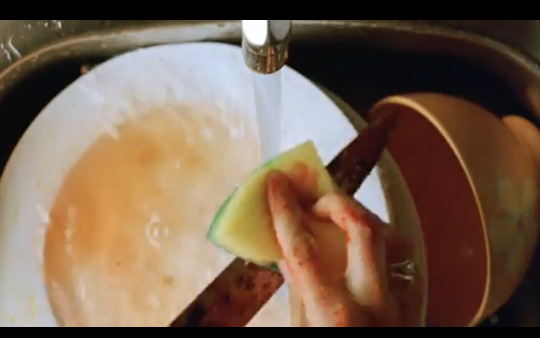
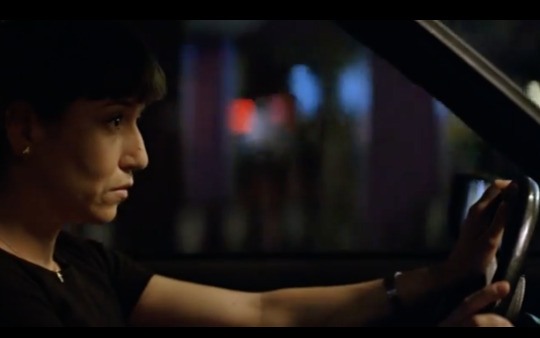
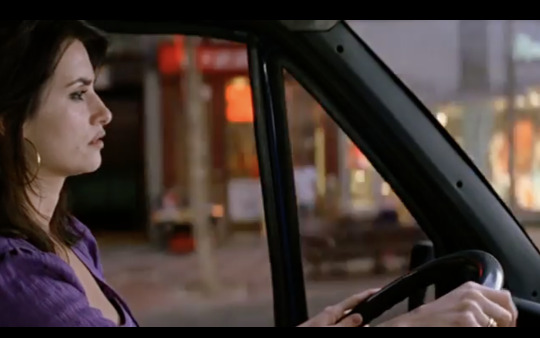
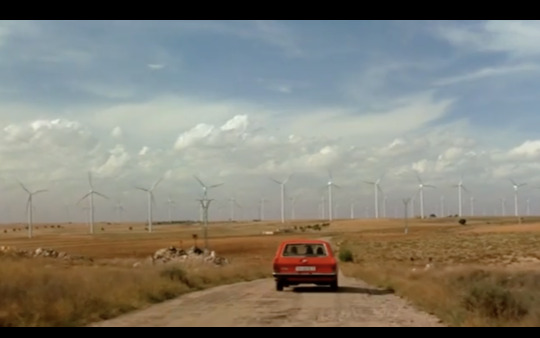
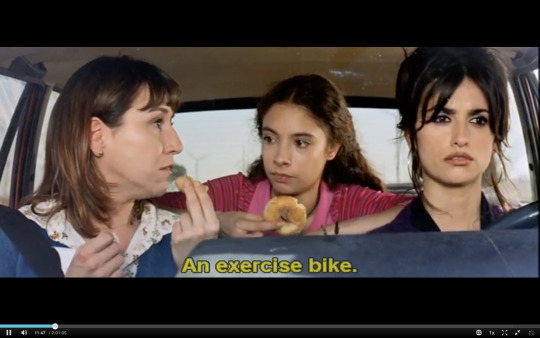

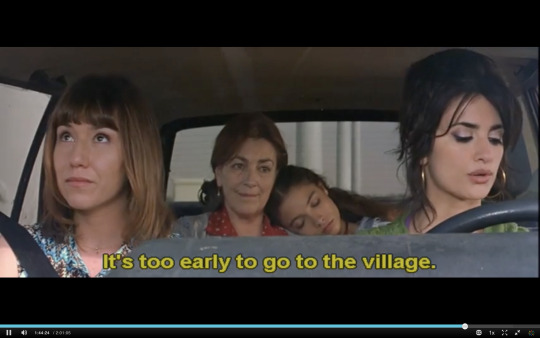

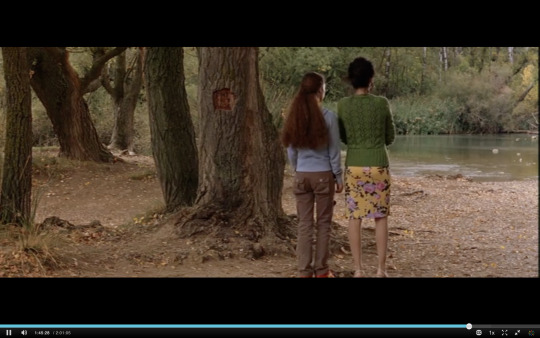
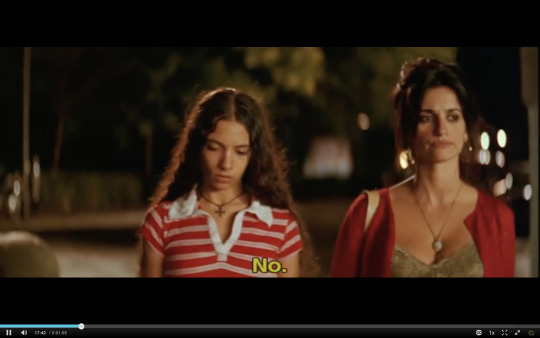
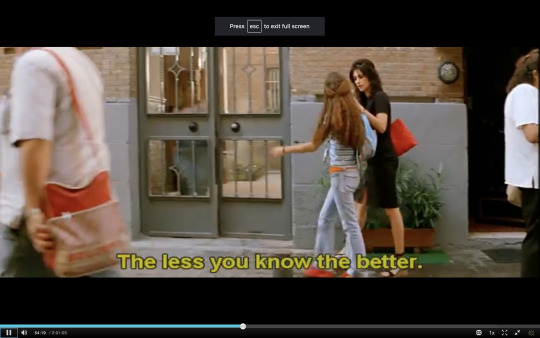
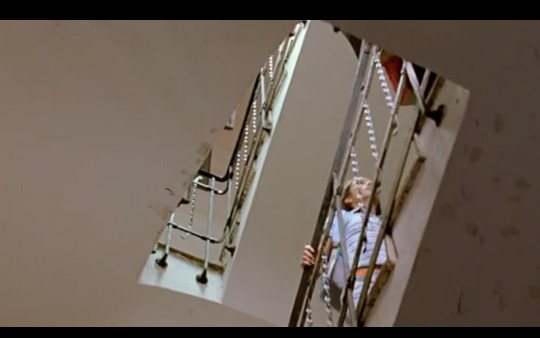
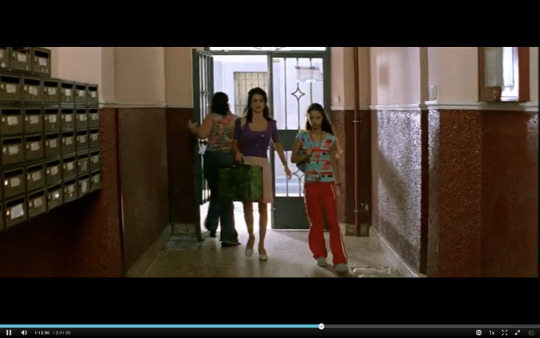
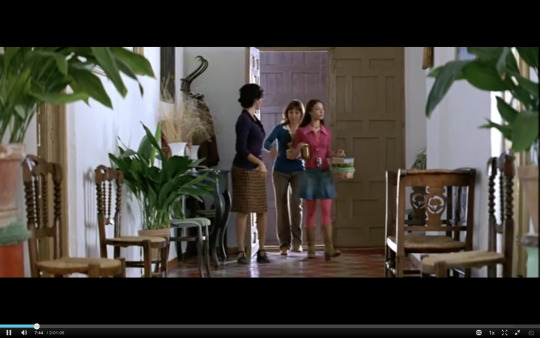


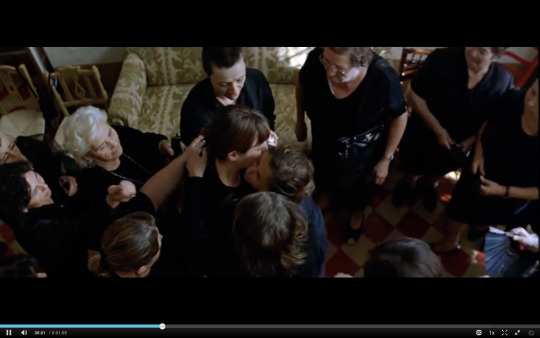
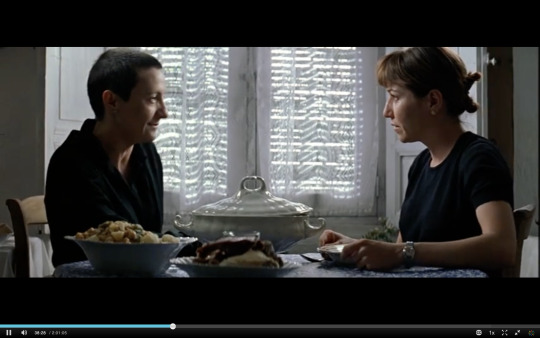
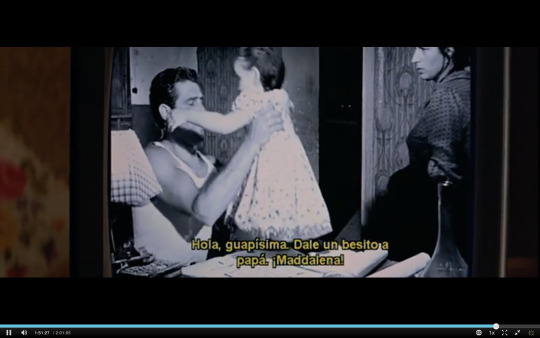


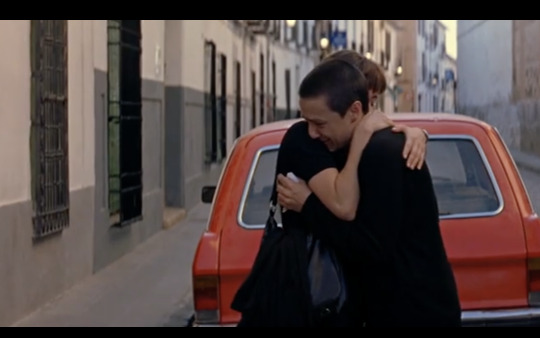
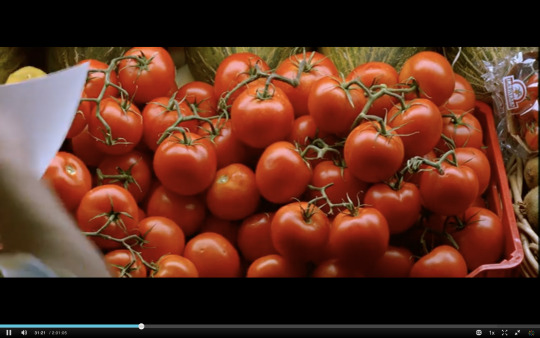
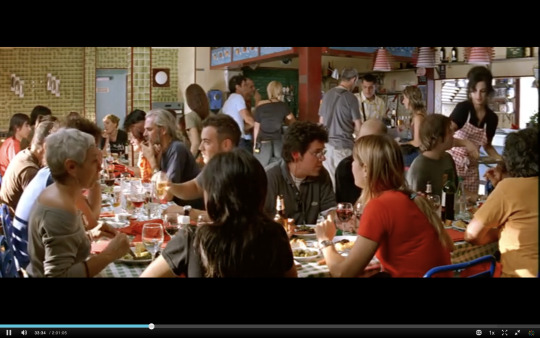
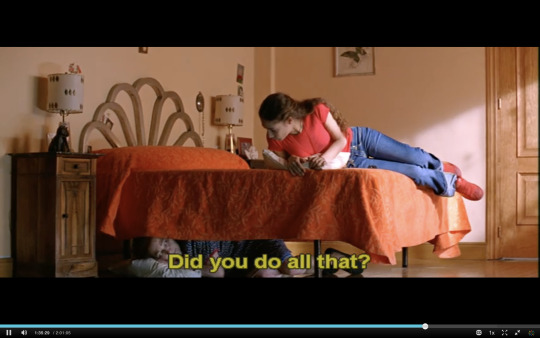
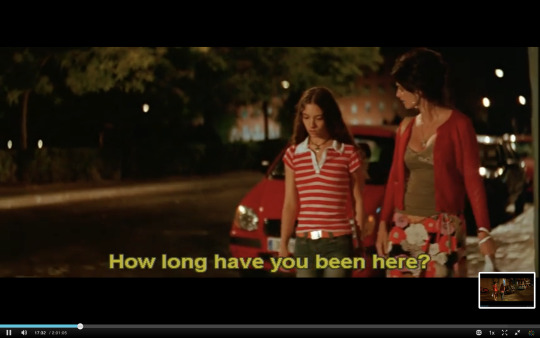

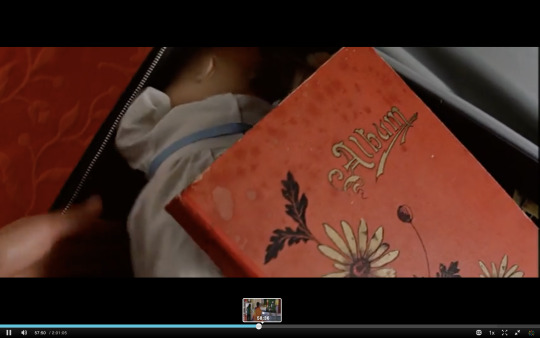
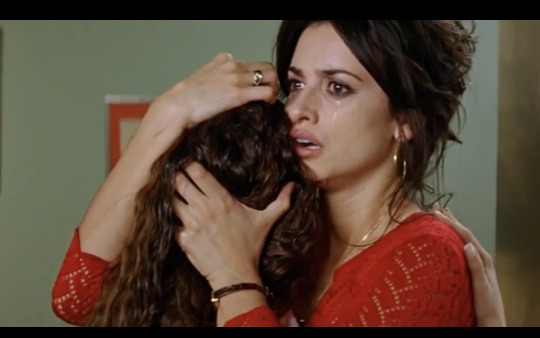
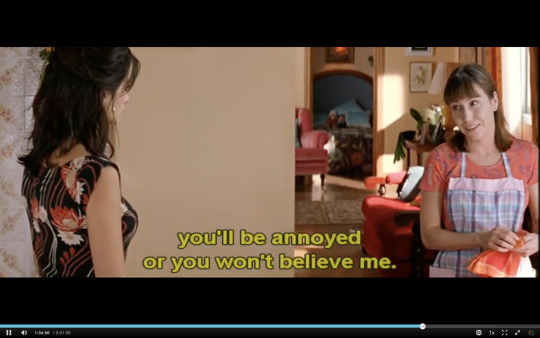
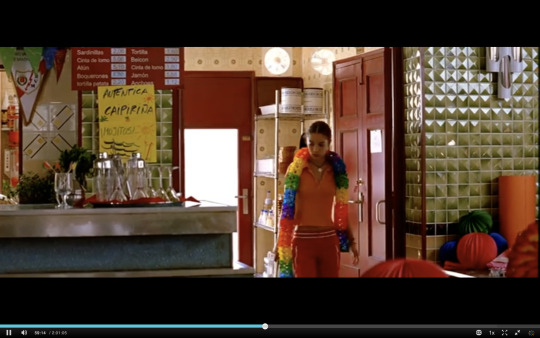
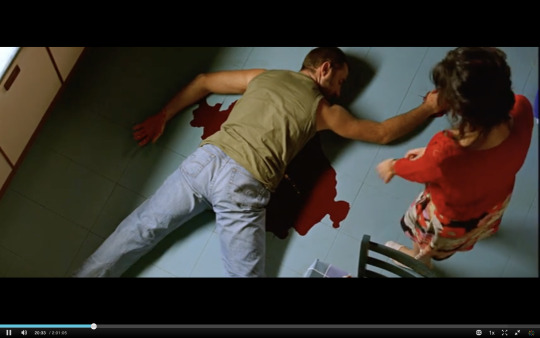

---------------------------------------------------------------------------------------
References
Merin, Jennifer. “Jennifer Merin Interviews Pedro Almodovar Re ‘Volver.’” ALLIANCE OF WOMEN FILM JOURNALISTS, 13 Dec. 2006, awfj.org/blog/2006/12/13/jennifer-merin-interviews-pedro-almodovar-re-volver/.
Team, Amuse. “A Musical Tour of Ibiza.” Amuse, 24 Mar. 2021, amuse.vice.com/en_us/article/bvg3p4/a-musical-tour-of-ibiza.
Lester, Paul Martin. Visual Communication: Images with Messages. Sixth ed., Michael Rosenberg, 2014.
Almodóvar, Pedro, Agustin Almodóvar, Esther García, Penélope Cruz, Carmen Maura, Lola Dueñas, Blanca Portillo, Yohana Cobo, Chus Lampreave, Antonio . Torre, Carlos Blanco, José L. Alcaine, and Alberto Iglesias. Volver. , 2006.
19 notes
·
View notes
Text
Xena: Warrior Princess Review
During Pride Month 2020, I finally got around to watch ‘Xena’. A show that had been in my to-watch list for years, but never got around to start. And when I finally did, I was pleasantly surprised. It was not what I expected and it was everything I think my 11 year old self would have loved.

The one thing that surprised me about the show, was the lack of packaging. Even though it was a fantasy, it also played with different kinds of genres too. I’ve talked about this before in my other review - ‘Xena’ was made at a time when TV had very few rules/rarely had a set audience, since there were parts of the show that were clearly for kids and there were other parts that were clearly for adults (therefore had much more flexibility). I admired how they weren’t afraid to break barriers and touch on deep themes such as religion, morality, redemption, spirituality, motherhood, forgiveness etc - even more than shows of today are able. I also loved how they played into the idea of ‘murder’ and how much it can damage a person - not just the person who commits the act, but the many people affected afterwards. I wasn’t expecting it to be that extreme. It made me think that this must of been the inspiration for ‘Game of Thrones’.

I see a lot of comments here and there, saying how ‘cheesy and terrible’ it was but to just accept it because its part of the fun. And while like any show it does suffer from the occasional spell of bad writing (the whole of season 5) but it was also shown to be very aware of that fact and never took itself too seriously - unlike some shows I could mention.
And regarding the ‘cheese’ factor (what 90s show wasn’t) It definitely can be, but I would call it ‘camp’ and ‘experimental’ more than anything else. (Don’t diss the poor use of CGI - I’m personally sympathetic to what was avaliable to them at the time) The style of humour reminded me of Taika Waititi’s filmmaking. If you’ve watched any of his films such as ‘Hunt for The Wilderpeople’ or ‘Jojo Rabbit’, then you know what I’m talking about. I liked how little they cared about being accurate or logical, which added to the ‘bonkers’ element in the show - which you can see in all of Taika Waititi’s films.
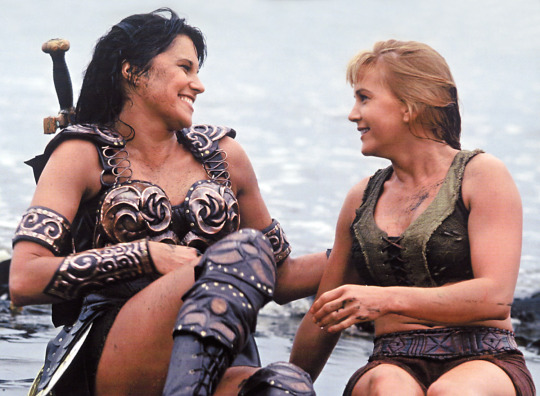
In all seriousness, a show centered around two women in their late twenties, who are realistic sizes (not trying to play teenagers). One of whom is a reformed mass murderer, who has lived a life experience, trying to do good in the world for the first time, picking the other one up who has no life experience prior (after they bugged them until they said ‘ok fine’) in their path to redemption. Just two women who become friends travelling the world together, fighting crime, having a laff, learning from one another without any toxicity - when suddenly when the stakes are raised - they realise ‘oh I'm actually falling in love with this person’ I have watched a lot of badly written shows in my childhood enough to know that, that’s not ‘cheesy’. I’ve never seen a story like that in my entire life. I’m not at all surprised that Russel T Davis was inspired by it while writing the Doctor and Rose’s relationship in ‘Doctor Who’ since he’s gay himself.

What’s more amazing about their love story is how they’re both develop as separate people as well. There was this video essay explaining ‘Why you should watch Angel’ the spin off series to Buffy; how ‘Buffy The Vampire Slayer ‘was all about growing up and ‘Angel’ was all about being an adult. With Xena: Warrior Princess, you have both of those stories at the same time.
Xena’s character was such a multifaceted experience to watch. And I can’t imagine anyone else who could play her as well as Lucy Lawless. What planet did they get that actress from? She's flawless! The amount of skill she has to put herself into a very physical role is astonishing. I personally had a love/hate relationship with her character all series long. Not in the way that I hated her, just that I couldn’t trust if she was all good or bad, which I know was intentional on the writers part. I haven’t seen a character quite like her before. She felt very much like a fallen angel; almost like the villain of her own story. Some of my favourite episodes come from fleshing out her character and dark past (‘Locked up and Tied Down’ is one of them) which reminds the audience that's she's not the stereotypical hero everyone expects. I loved her transformation from being this incredibly stoic warrior to being content and happy with who she is in season six, all because of a woman she fell in love with along the way.
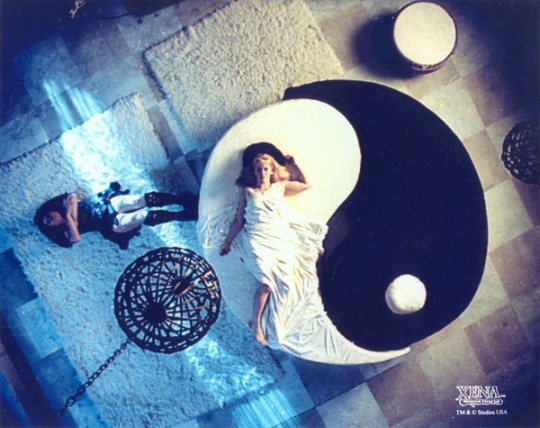
I’ve always thought of Gabrielle as the real hero and narrator of ‘Xena’. She’s the prime example of ‘a normal person becoming extrodinary’. Gabrielle’s coming of age story starting out as an innocent girl from a poor village dreaming of adventure, and ending as this vicious warrior who realises the ‘adventure’ wasn’t how she made it out to be is honestly the best character arc that I’ve ever seen. I loved how travelling with Xena made her realise her passion for writing (which was never going to happen in her home town, given the ‘sexist’ and ‘heteronormative’ ideas) and that she became a amazon princess like Xena. In regards to her sexuality, which is more up for debate than Xena’s (which I think we can all agree is bisexual) I personally interpret her as gay, just in terms of how she was written. Theres this moment in season 4 where she's being held up her hair, and Xena “symbolically” cuts it off ‘freeing her’. And she never really gets with a man afterwards, unless she’s being ‘possessed. It reminded me of a moment in one of Hayao Miyasaki’s films ‘Laputa, Castle in the Sky’ where the bad guy Moska shoots Sheeta’s ‘princess hair off’ which symbolises her transition from child to adult.

The cinematography was breathtaking. There was some great utilisation of New Zealand as the scenery. So was the soundtrack. You could tell it was made by experienced filmmakers. One of my favourite things about the show was the domestic elements - moments in the show where time seemed to stop - which made the world around the characters seem very real and magical. Even though it was a show that featured a lot of action/adventure, there was also this gentleness to it as well. For example, you could feel the wetness of the rain, the warmth of the sun and the clashing of the waves. This technique is used in Hayao Miayasaki’s work a lot .
The technique is referred to as ‘MA’ 空虚 meaning emptiness in Japanese. ‘Miyasaki describes this as the time between a clap’
“If you just have non stop action, with no breathing space at all, its just busyness. But if you take a moment, then the tension building in the film can grow into a wider dimension” - Hayao Miyasaki
undefined
youtube
The episode ‘A Day in the Life’ in season two is a really good example of this technique being used.
To my understanding, they used a lot of the local actors in New Zealand, which according to Lucy Lawless, consisted of ‘African immigrants and other different ethnicites’. It was so refreshing to see such a diverse show (despite some slip ups) especially in the 90s. I appreciated the idea that if the actors or extras couldn’t do an ‘american accent’ people could just talk in their natural speech which was also very refreshing.
The LGBT representation was surprisingly amazing. I never expected so many queer characters in one show - especially under the censors. There was this one episode where they had a trans woman - played by an actual trans actress - win a beauty contest. It made me cry. Not to mention the actress was an aids activist. It was actually Lucy Lawless’ idea to kiss her which was incredibly controversial at that time considering how everyone thought you could catch aids just by kissing. I can definitey see how it validated people back in the 90s.
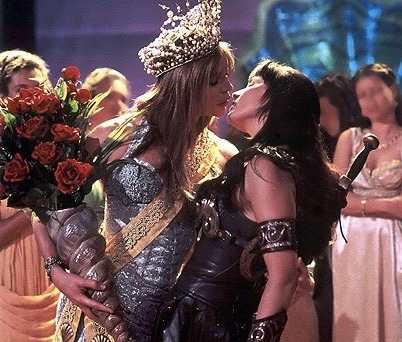
When people told me that Xena: Warrior Princess was one of the greatest love stories, I thought they were exaggerating a little. But no, watching the show in context, I found out that it really is. Despite its obvious restrictions, It made me realise (regarding token gay couples today) how often television writers rely on physicality and drama to convey a ‘love story’ and how much of it is actually pandering the audience. One of the reasons why Xena and Gabrielle’s relationship felt so genuine is because it was built on mutual respect/compassion and they were also best friends. I felt like I was witnessing something very real and private. It didn’t need kissing scenes or drama to make it interesting.

It really helped that most of the writers were queer also. There’s this opening scene in season 4, panning over to Gabrielle giving Xena a massage (metaphor for sex - because they weren’t able to show that on screen) which I consider to be one of the most iconic scenes in media - considering how I wanted to sick up my supper when I watched the 10 minute ‘empty’ explicit sex scene in ‘Blue in the Warmest Colour’. The difference when something is written by a queer women vs a straight man.
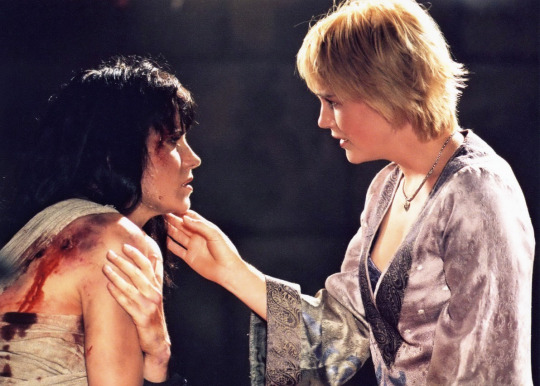
Because the creators weren’t allowed to write their love story in the normal way, due to the studio forbidding them to, they found creative ways to showcase that love on screen - which made for a very magical/sensual experience. And I can safely say, if anyone has doubts about watching ‘Xena’, whenever I expected to be queer baited at a few points in the show, I was proved wrong time and time again. It’s the most romantical show I’ve ever seen in my life!
#xena: warrior princess#xena#xena x gabrielle#review#rating#analysis#renee o'connor#Lucy lawless#90s show#lgbtqia#lgbt#pride month#-- it truly is a unique show#gabrielle#studio ghibli#hayao miyasaki#quote#film#reference#fantasy#lgbt representation#lgbtqia representation#doctor x rose#xena x gabby#subtext#happy pride 🌈#queer subtext#xwp#xena and gabrielle#xena & gabrielle
286 notes
·
View notes
Photo

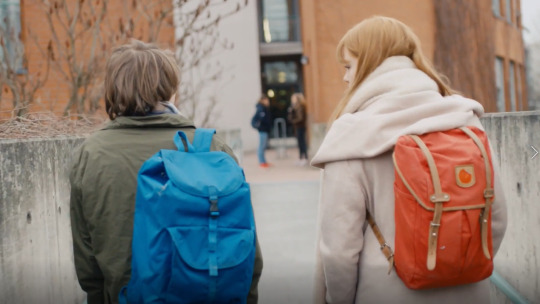

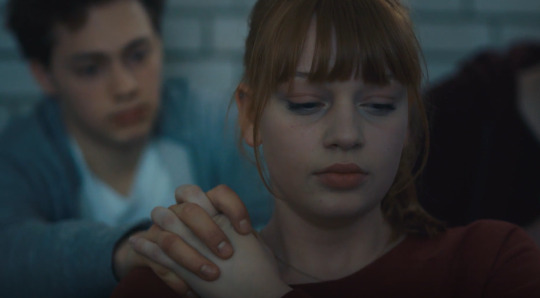
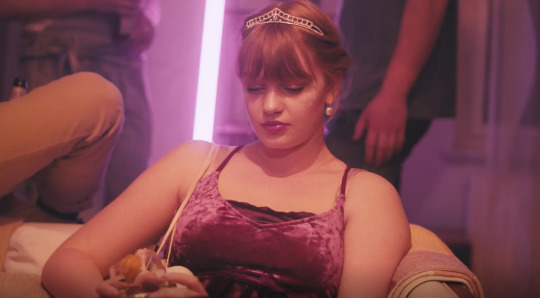
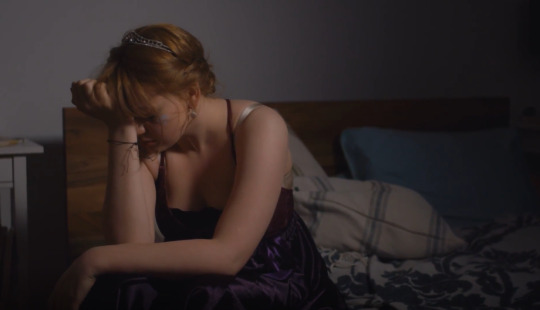

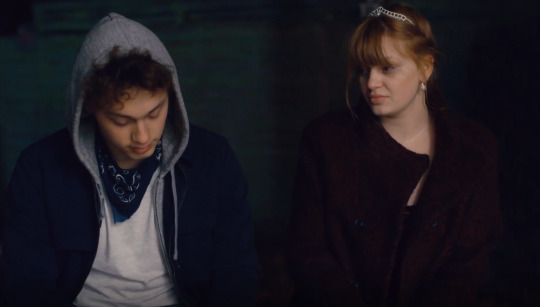
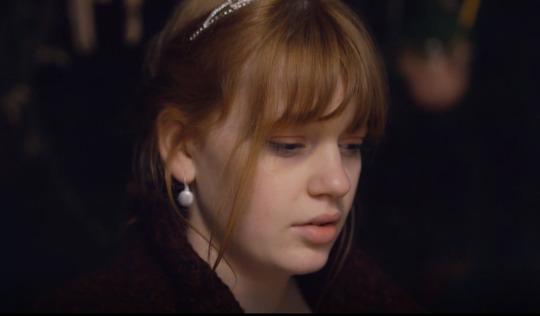
Hanna, episode six
1. This ramp thing. It’s the MVP of this whole entire school/setting. I mean I can see why they use it - it allows for some really cool shots and set ups and it genuinely works in so many ways to show so many nuances of the situations it’s in. But basically I just love the continuity. There’s something so comforting about this returning over and over and over again. The sheer joy of ‘the ramp! It’s here again!’
2. Matteo’s little ‘why are you dating Jonas?’ is so interesting too. This speech carries a different tone, and I can’t tell if that’s because of the way it’s said. He genuinely seems to be like ‘Hanna, think this through - do you really want this?’ and the answer should actually be ‘no I don’t’ even if his motives aren’t great, and maybe it’s because she’s different to Eva. Or maybe this is because as always while it leans heavily on the original, the lines aren’t exactly the same and that lends some differences to it. I don’t know. Plus her question ‘there’s only 2 options: trust or break up?’ and his reaction ‘or maybe talk to Leonie’ - like yes. Please. Do that. Communicate with people. But I guess he knows it won’t go well because he likely knows exactly what Jonas is doing, and so he has very little to lose. He’s not overtly being a dick here, and he looks supportive. So if it goes well for her, hey he looks like the supportive good friend and if it doesn’t. Well... that’s not his fault. He was just trying to help. At this point, from his PoV, not much can go wrong.
3. The little scene at school with Jonas telling Hanna she’s annoying (by text! so distant and cold. Ugh, talk to each other properly please), and then Sam making her feel good and sexy and wanted. You can see why she’d be taken by him. We can see he’s a bit of a player, far too smooth and good at this, but of course she can’t. With Matteo’s ‘break up with Jonas if you don’t trust him’ ringing in her ears, you can see why she feels the way she does. Again, so much of this is modeled on the original, but the way it’s shot works so well here in terms of specifically showing us Hanna’s state of mind. With Hanna literally feeling like she’s got this barrier between her and Jonas after he sends his last text, shown literally in the way the moment is shot. Plus, Kiki’s little thing with Alex as a mirror/reflection of what’s happening with Hanna (they literally fistbump over it - Alex over having got his conquest and Sam over pursuing his). She has all the warning she needs and yet she falls into it anyway. This whole part of this season is so heartbreaking, and knowing where it’s leading is tough. This week is a hard one for our little bean.
4. I know everyone and their dog has talked about this cold war scene but that’s because it’s so damn good. The imagery and the whole way this scene works is so powerful. Plus, we’re veering even more into the darker shades for Hanna. This thing with Jonas is weighing on her and literally sucking out her brightness. She’d been so washed out at the start, and when she’s with her girls it’s all still brightness etc, but with Jonas this darkness is seeping in more and more and more. I mean he is lying to her and that’s where almost all of this ‘cold war’ conflict is coming from, but her relentless pushing of the topic is a lot. AND she never does it when they’re in a place where they can just talk about it, the two of them. They’re around the boys or in class and by text. She’s scared of knowing for sure and so she puts these barriers up to avoid having to do it properly. But this is the entire problem. I know we say communication is an issue across the board with these couples, but I’d argue (and have at length) that it’s not always true. For some it’s different. But here. Here, this avoiding of doing it properly is the biggest issue.
5. Okay, so Amira suddenly reappears here. But???? Where has she been???? I missed her so much!!! I love Sana, I really really do. She’s a fabulous character and I adore the way she operates in Skam. But I do love that Amira is her own character and so, while delivering a very similar message, is much warmer about it. She tells Kiki she’s stupid for sending nudes, and that Alex really isn’t into her, but her tone isn’t as harsh or ‘straight to the point’ somehow. But of course Amira is still tone policed by her friends, and told to say things more carefully. And then she leaves, delivering another blow to Hanna’s confidence in Jonas. ‘Boys lie’ - thus confirming everything she already thinks.
6. I’ll hand it to Druck - I always love their party scenes; they feel real, like people genuinely having fun dancing and stuff (though in the most recent seasons that seems to have dropped off, probably because of restrictions having an effect on how they can film). Leonie looks damn good in a suit too; this is a great look on her. But wow her attitude to Hanna is so nasty. It’s fascinating to me to see that Sara acts just as jealous and can’t let it go after Matteo breaks up with her. They clearly have a model for how they deal with break ups and it’s not a good one. Obviously Leonie is hurt, obviously it super sucks that it’s her best friend. But this whole bit is so unnecessarily mean. She wants Hanna to be hurt the way she was and she’s taking such a vicious pleasure in the way that it works. Like, yes Hanna is to blame, but man some of this ire should be directed at the Jonas in the situation.
7. I can see why she falls for Sam’s wiles here, and there’s been so much stuff in the last few episodes leading up to it but gosh it sucks that she falls for it. He knows she has a boyfriend, he can clearly see she’s vulnerable and he takes advantage of that. He is very cute, I can see why she likes him, but I don’t like this type of guy and he and Alex really annoy me (though somehow Alex doesn’t feel as slimy with it as William - at least so far). And then Hanna watching as the scene of another cheating episode plays out in front of her. No wonder she thinks the way she does: all she has are examples of guys being assholes. But it does need to be mentioned that she stops this kiss almost as soon as it started. I’m not sure this exactly counts as cheating. But I guess what’s important is that Hanna feels like she’s in the same place she already was. Plus now she knows how it feels from the other side. This evening is such a stress for her. The little story that Jule tells her about how Sam ‘would never do that’ is just the icing on the cake. This is a moment where I always feel so awful for Eva/Hanna/all of them.
8. Jonas’s sad little confession comes just that little bit too late, and you can see the regret hanging over Hanna. Like, she already felt it and now she can see through everything and it all sucks. And of course the darkness has totally closed in rn. But I do have to say I love Jonas’s ‘not that I know anyway’ about whether he’s gay. The characters in this show are far less worried about sexuality and ‘being straight’ and it’s a nice thing. Matteo was all ‘yeah I like gay songs, so what?’ and Jonas here. I like it. But ouch, how ‘you can trust me’ must hurt when they haven’t been trusting each other and it’s become so fraught. Notice also that they don’t fall back on their kissing this time. The one thing that’s been going well for them isn’t working anymore either. At the point where things are ‘darkest’ for them in the cinematography etc, we also get the moment when they can’t connect in any of the ways they used to. Jonas is talking and being open finally, but Hanna is now hiding things and nothing here is going well for her.
Anyway, this is a really difficult episode and yet it’s one of my favourites. Like episode 2 I’m just a real sucker for the way it’s filmed. Again, everything is lifted almost entirely from the original and yet again Druck puts its own little spin on it. There’s a reason why the original and this one are the ones I like. Both take a lot of care with how colour and symbols etc work and play out and while this is a straight copy in so many ways, I still love how they chose to interpret it. Their characters are subtly their own, the filming has its own life and that makes it work for me.
#druck#og druck#hanna episode 6#I won't be doing any of these for a few days#found out today I have a ginormous job at work#and 2 days to get it done in - which I can'[t start until tomorrow#so sadly I'll be super busy til the end of the week
13 notes
·
View notes
Text
If I was a Love Interest in Sweet Elite
In the game, I’ll be a highly fictionalised version of myself, my personality stays the same. Also, I am a WOC (woman of colour), so I am going to reveal my ethnicity. Also im rich as fu-
(following the student file format)
Student File
(General Information)
Name: Amara Olalia (my scholar’s name, so im using it here)
Gender: Female
Department: Fine Arts
Concentration: Screenwriting and Filmmaking
Height: 5′6/167 cm/1.67 meters
Ethnicity: Filipino
Nationality: Filipino/American (dual-citizen)
----
(Skills)
Creativity: ⬛️⬛️⬛️⬛️⬛️ /5
Academics: ⬛️⬛️⬛️⬛️ /5
Teamwork: ⬛️⬛️ /5
Extracurricular: ⬛️⬛️⬛️⬛️ /5
Technique: ⬛️⬛️⬛️⬛️ /5
----
(General Comments)
“Amara is a highly creative storyteller with intricate characters and symbolic cinematography. Her witty and very relatable dialouge in her scripts makes it feel real. Despite that, she is quiet, asocial, and hates working with people. Her concentrating in filming and writing is a weakness, if she doesn’t tell those her ideas. As I know it will be better than everyone else’s. What I have seen in the classroom, she is empathetic and emotional, which is one of her best traits. If she learns how to trust others with those exact qualities; where she can comfortably open up and reveal her plans, she can win awards with her future work.” - Prof. Robert Boss
----
(Academic Record)
Strengths: Humanities, Fine Arts, Performing Arts, History
Weaknesses: Mathematics, Physics, Chemistry
Notes: “Amara knows how to tell a story through different perspectives, more talented than other aspiring filmmakers. Thanks to that, she knows how to build off the ground well. But she daydreams often.” - Prof. Robert Boss
----
(Health Record)
Highly prone to mental burnouts
----
(Awards & Honors)
Won in National Film Festival for Talented Youth
See comprehensive list of won short story competitions
----
(Disciplinary Action)
Detention for not wearing uniform
Special permission: Can wear own version of uniform (as long is wearing pin or emblem)
----
(Extras)
Works with the Fine Arts Department student led newsletter (Arlington News)
----------
My Character Arc (insert dramatic anime music)
I’d mention that I have a strong attachment to my family, especially my extended family (its true). It started when I became closed off and prone to crying, scholar and the 10 will become increasingly concerned, but Ellie was the first to find out. Scholar know that I never reveal too much about myself, but I know too much of others (like Neha’s status). When I finally open up that a close relative of mine passed away, the 10 finally saw how I actually feel for once. My emotions cannot be handled in a healthy way, so I just lash out. Eventually getting in a fight with Karolina. She said that seeing me geniunely angry was one of the scariest things she had ever seen. Scholar will soon confront me, and I’d let it out. On how I can’t go back home to hug my family and properly mourn. The 10 help set up with a virtual funeral, so I can still be there. My arc being resolved. Learning to open up about my issues and saying my actual opinions.
----------
My relationships with the Main 10/Other things
Besties!!!: Tyler, Ellie, Tegan (TENT BITCH)
Besties, but won’t say anything about it to Karolina until later: Neha
Close; Karolina, Raquel
Good terms: Alistair, Claire, Axel (mixed)
Its confusing, but we like each other: Tadashi
-----
Notes from relationships
Tegan and I play Smash Bros a lot to settle our arguements (i main byleth and roy)
Tyler, Ellie, and I dramatically act out my stories
Neha and Karol often invite me to go shopping with them
Karol actually tolerates and likes me, because of my relationship with Neha
Axel doesn’t like it when I criticise his new music, but he takes it as constructive
Raquel and Alistair watches sports anime with me (both get hyped while watching Haikyuu)
Claire gives me some plants she grew so I can send it to my mom as a gift
Tadashi and I have a brother and sister relationship (but he attacks me for not wearing my uniform at all)
----
Uniform (but I actually despise uniforms)
I wear black boyfriend jeans, with an oversized college sweatshirt with the school’s emblem over the collared shirt. Wears white high top converse with shin high wool socks. Sometimes I would wear the skirt with black thigh highs, but its very uncommon. (in my first year, Tadashi and I had a fight about it. It’s where I first called him Nakahoe)
----
Yeah, I'm rich as fu-
My family would own a software engineering company. Both parents would promote my creativity. I was born in America, but parents from the Philippines.
----
Favourite/Least Favourite things
Likes: TV shows, movies, writing, family
Dislikes: Entitled people, hierarchies, science class
----------
Would Scholar like me as a friend or love interest?????
They would like me because I often make jokes that fits any kind of scenario (I actually do that). I would often rant about my stories, so they might find me endearing or cute because I love my characters from it. I’m also emotionally intelligent, so I often comfort Scholar, and know how they feel (I’d do that for my friends).
Why they would not like me, is because I never reveal anything personal. Compared to the others, who casually mention it sometimes (ie: Tadashi saying he is part of the Nakano family). I wouldn’t say about how I’m actually feeling or issues, but after my arc; I’d slowly open up.
15 notes
·
View notes
Text
25 more movies (and one miniseries) you can watch on youtube
I posted 11 movies that are on youtube yesterday (Part 1) but since things are really starting to get shut down here’s more worthwhile movies and a miniseries you can watch for free on youtube right now
Leave Her To Heaven (1945): Gene Tierney is Ellen, a woman whose only crime is “loving too much,” and also all the other crimes she commits to make sure there are no competitors for husband Cornel Wilde’s affections in John M. Stahl’s incredibly lurid and entertaining technicolor melodrama.
M (1931): Fritz Lang’s masterpiece is the basis for every subsequent movie about hunting a serial killer and it’s still the best one.
The Naked Kiss (1964): Here’s the jacket copy from Criterion: “The setup is pure pulp: A former prostitute (a crackerjack Constance Towers) relocates to a buttoned-down suburb, determined to fit in with mainstream society. But in the strange, hallucinatory territory of writer-director-producer Samuel Fuller, perverse secrets simmer beneath the wholesome surface. Featuring radical visual touches, full-throttle performances, brilliant cinematography by Stanley Cortez, and one bizarrely beautiful musical number, The Naked Kiss is among Fuller’s greatest, boldest entertainments.”
Underworld USA (1961): Dave Kehr on the film: “Sam Fuller's harsh, obsessional 1960 crime drama is narrated in the style of a comic book gone berserk. Cliff Robertson is the neurotic hero, bent on avenging his father's death by infiltrating and destroying a crime syndicate that operates under the redolent name “National Projects.” Corruption is all-pervasive in this vision of America, and Fuller disturbingly suggests that only a madman can make a difference. One image from Underworld—of a heavy striking straight at the camera—prompted Jean-Luc Godard to describe Fuller's films as “cinema-fist.” There is no more apt phrase.”
Pickup on South Street (1953): Another Sam Fuller. Here’s Georgia Hubley of Yo La Tengo on the film: “Richard Widmark manages to portray himself as twisted, conniving, pathological, sleazy, tragic, vulnerable, and handsome all at once in most of the movies I’ve seen him in, and never more exquisitely than in this, one of my favorite film noirs.“
Journey to Italy (1954): Richard Brody on the film: “One of the most quietly revolutionary works in the history of cinema, Roberto Rossellini’s third feature starring Ingrid Bergman (his wife at the time), from 1953, turns romantic melodrama into intellectual adventure. [...] From Rossellini’s example, the young French New Wave critics learned to fuse studio style with documentary methods, and to make high-relief drama on a low budget.”
The Spook Who Sat By The Door (1973): A satirical thriller based on the Sam Greenlee novel about the CIA recruiting a token black agent who quickly realizes they have no intention of letting him advance to a meaningful position and decides to head back to Chicago to teach the black revolutionaries all the latest guerrilla warfare tactics. Despite playing to packed houses the film was quickly pulled from theaters with little explanation and remained out of circulation until a DVD was issued in 2004.
The Big Combo (1955): Dave Kehr’s capsule: “This 1955 film noir borders on total abstraction for most of its length and then achieves it in an astonishing final scene—a shoot-out in the fog that suggests an armed and dangerous Michelangelo Antonioni. Where the usual noir takes place in a nightmare world, this one seems to inhabit a dream: there's no longer fear in the images, but rather a distanced, idealized beauty. With Cornel Wilde, Jean Wallace, Brian Donlevy, and Richard Conte; the director is Joseph H. Lewis (Gun Crazy).”
The Stranger (1946): Orson Welles’s film concerns an FBI agent (Edward G. Robinson) tracking Nazi war criminals whose search takes him to a small Connecticut town where the local schoolteacher (Orson Welles) is not what he seems. It’s the most conventional Welles film, reportedly intended to prove he could turn in a movie on time and on budget, but it’s still plenty entertaining.
F For Fake (1973): Orson Welles documentary/essay/whatsit about forgers and frauds, specifically Elmyr de Hory, who became famous as an art forger because instead of forging existing paintings he painted new ones in the style of famous artists, and Clifford Irving, who wrote a best-selling book on Elmyr and then was busted for a fraud of his own, the fake Howard Hughes autobiography. A wildly enjoyable, incredibly edited, one of a kind mindbender.
Citizen Kane (1941): It’s Citizen Kane. You just have to put up with hardcoded Korean subs.
Detour (1945): Roger Ebert on the film: “Detour is a movie so filled with imperfections that it would not earn the director a passing grade in film school. This movie from Hollywood's poverty row, shot in six days, filled with technical errors and ham-handed narrative, starring a man who can only pout and a woman who can only sneer, should have faded from sight soon after it was released in 1945. And yet it lives on, haunting and creepy, an embodiment of the guilty soul of film noir. No one who has seen it has easily forgotten it.”
A Woman Under The Influence (1974): Dave Kehr: “John Cassavetes's 1974 masterpiece, and one of the best films of its decade. Cassavetes stretches the limits of his narrative—it's the story of a married couple, with the wife hedging into madness—to the point where it obliterates the narrator: it's one of those extremely rare movies that seem found rather than made, in which the internal dynamics of the drama are completely allowed to dictate the shape and structure of the film. The lurching, probing camera finds the same fascination in moments of high drama and utter triviality alike—and all of those moments are suspended painfully, endlessly. Still, Cassavetes makes the viewer's frustration work as part of the film's expressiveness; it has an emotional rhythm unlike anything else I've ever seen.”
Opening Night (1977): Another Cassavetes masterpiece, again starring the great Gena Rowlands, with Gena as an actress mentally disintegrating as she tries to prepare for an upcoming play. Easier to start with this one than A Woman Under The Influence. Richard Brody on the film: “Though there isn’t a movie camera anywhere to be seen—and Cassavetes, with his tightly sculpted, uninhibitedly intimate images, is a master of the camera—Opening Night captures with astonishment and boundless admiration the uninhibited ferocity of the art that brings life onto the screen. (In fact, Cassavetes had originally planned to take the role of the play’s director.) It’s one of the greatest tributes ever paid by a director to an actress.“
Magnificent Obsession (1954): It’s not necessarily Douglas Sirk’s best technicolor melodrama but this adaptation of Lloyd C. Douglas’s ridiculous bestseller is the most melodramatic one. From Cine-File: “Produced in the wake of Henry Koster's CinemaScope adaptation of Douglas' THE ROBE, Sirk's 1954 remake of MAGNIFICENT OBSESSION is, by any standard, an absolutely batshit movie. (It's the kind of film where a lecture about the radical power of kindness compares the crucifixion of Christ to the act of turning on a light bulb.) It's not so much an adaptation of Douglas as a third-hand amplification of his aura. "Ross Hunter gave me the book," Sirk recalled, "and I tried to read it, but I just couldn't. It is the most confused book you can imagine.” As Geoffrey O'Brien asserts in his essay for the film's Criterion release, Sirk earnestly examines that which he admits to finding absurd, forcing such questions as, "What if this weren't crazy? What if it were real? What sort of a world would that be, and how different would it be from the one we inhabit?" Therein lies the genius of Sirk's glorious melodrama, one certainly worth seeing in all its Technicolor magnificence.
All That Heaven Allows (1955): Geoff Andrew on the film: “On the surface a glossy tearjerker about the problems besetting a love affair between an attractive middle class widow and her younger, 'bohemian' gardener, Sirk's film is in fact a scathing attack on all those facets of the American Dream widely held dear. Wealth produces snobbery and intolerance; family togetherness creates xenophobia and the cult of the dead; cosy kindness can be stultifyingly patronising; and materialism results in alienation from natural feelings. Beneath the stunningly lovely visuals - all expressionist colours, reflections, and frames-within-frames, used to produce a precise symbolism - lies a kernel of terrifying despair created by lives dedicated to respectability and security, given its most harrowing expression when Wyman, having given up her affair with Hudson in order to protect her children from gossip, is presented with a television set as a replacement companion. Hardly surprising that Fassbinder chose to remake the film as Fear Eats the Soul.“
Written on the Wind (1956): Dave Kehr: “One of the most remarkable and unaccountable films ever made in Hollywood, Douglas Sirk's 1957 masterpiece turns a lurid, melodramatic script into a screaming Brechtian essay on the shared impotence of American family and business life. Sirk's highly imaginative use of color—to accent, undermine, and sometimes even nullify the drama—remains years ahead of contemporary technique. The degree of stylization is high and impeccable: one is made to understand the characters as icons as well as psychologically complex creations.“
His Girl Friday (1940): Geoff Andrew’s capsule: “Charles Lederer’s frantic script needs to be heard at least a dozen times for all the gags to be caught; Russell’s Hildy more than equals Burns in cunning and speed; and Hawks transcends the piece’s stage origins effortlessly, framing with brilliance, conducting numerous conversations simultaneously, and even allowing the film’s political and emotional thrust to remain upfront alongside the laughs. Quite simply a masterpiece.“
Bringing Up Baby (1938): Ignatiy Vishnevetsky on the film: “Possessed by an overwhelming sense of comic energy, Howard Hawks’ screwball masterpiece heaps on misunderstandings, misadventures, perfectly timed jokes, and patter to the point that it’s easy to overlook how rich and fluid it is a piece of filmmaking, effortlessly transitioning from one thing into the next.”
Underworld (1927): Dave Kehr: “The first full-fledged gangster movie and still an effective mood piece, this 1927 milestone was directed by the master of delirious melodrama, Josef von Sternberg. George Bancroft is the hard-boiled hero, granted tragic status in his final sacrifice. Ben Hecht wrote the script, and many of the same ideas turn up, in a very different moral context, in his screenplay for Howard Hawks's 1932 masterpiece, Scarface.“
Q - The Winged Serpent (1982): In Larry Cohen’s cheapo classic, Quetzelcoatl terrorizes New York. Michael Moriarty plays a bumbling, unlucky small time crook (the robbery he participates in goes hilariously wrong; losing the keys to the getaway car is just the start) who accidentally discovers the monster’s nest and realizes he’s stumbled into the opportunity of a lifetime. He’s willing to help the authorities, including cops played by David Carradine and Richard Roundtree, but they’re gonna have to pay for it. Very goofy and very fun.
Stalag 17 (1953): Billy Wilder’s classic mixes POW drama with comedy as a group of prisoners in a German POW camp try to figure out who in their barracks is a rat while they plan their escape.
Hellzapoppin (1941): Ignatiy Vishnevetsky: “The opening reel may be the most manic stretch of go-for-broke gonzo comedy to come out of studio-era Hollywood, with the zoot-suited duo of Olsen and Johnson introduced tumbling out of a New York taxi into the bowels of hell (“That’s the first taxi driver that ever went straight where I told him to!”) in the midst of a musical number about how “Anything can happen / And it probably will.” Dozens of throwaway gags—including the first Citizen Kane reference in film history—and an argument with the projectionist (once and future Stooge Shemp Howard) follow, before the movie snaps into something vaguely resembling sanity. From there, Hellzapoppin’ finds Olsen and Johnson wandering in and out of a musical comedy that’s seems to be on the verge of falling apart and tussling with such comedy ringers as Martha Raye and Mischa Auer, the latter cast as a real Russian nobleman who’s trying to pass as a fake Russian nobleman. It’s like a Marx Brothers movie playing at triple speed; it eludes easy summary—it’s a real “you have to see it to believe it” kind of movie—and often stretches the limits of the Production Code. True to its absurdist sensibility, Hellzapoppin’ ended up getting nominated for an Oscar by mistake, for a song that doesn’t appear in the movie.”
Outrage (1950): Directed and cowritten by Ida Lupino, this was one of the first Hollywood movies after the implementation of the production code to deal with rape and one of the first to tackle its psychological aftermath (the censor office actually made them take the word “rape” out of the script so it’s never uttered in the film). Richard Broday on the film: “Outrage is a special artistic achievement. Lupino approaches the subject of rape with a wide view of the societal tributaries that it involves. She integrates an inward, deeply compassionate depiction of a woman who is the victim of rape with an incisive view of the many societal failures that contribute to the crime, including legal failure to face the prevalence of rape, and the over-all prudishness and sexual censoriousness that make the crime unspeakable in the literal sense and end up shaming the victim. Above all, she reveals a profound understanding of the widespread and unquestioned male aggression that women face in ordinary and ostensibly non-violent and consensual courtship.“
The Hitch-Hiker (1953): Another Ida Lupino joint, this one a lean and mean film noir. J. Hoberman on the film: “The “Hitch-Hiker” script, written (uncredited) by the socially conscious journalist Daniel Mainwaring, was inspired by an actual case: Two buddies (Frank Lovejoy and Edmond O’Brien) pick up a murderous psychopath (William Talman) who forces them to drive him to Mexico. It’s a brutal story handled by Ms. Lupino, one of Hollywood’s very few female directors, with the same steely determination and emotional sensitivity found in her strongest performances.”
And the miniseries:
The Singing Detective (1986): Here’s the entry from the BBC’s list of the top 100 British television programs, where it placed number 20: “For many Potter's masterpiece, this extended six-part filmed drama series mixes flashback and fantasy to create a psychological profile of a writer of detective fiction hospitalised by a crippling skin disease. Though not, the writer stressed, autobiographical, the drama features many elements from both Potter's own life (the disease, the childhood setting) and his body of work (particularly the use of popular music from the war years). As usual with Potter, it also caused controversy at the time for the frankness of its sex scenes, though its position as one of the most challenging and inventive of all TV dramas is secure.“
181 notes
·
View notes
Text
Watch this film?Your Here: Film's Hidden Messages

Have you ever watched a movie and felt like there was something more to it than meets the eye? Like the filmmakers were trying to convey a deeper message? You're not alone. Many movies contain hidden messages and meanings that may not be immediately apparent to the casual viewer. This article delves into the world of film analysis and interpretation to uncover the cinematic storytelling techniques, film symbolism, and subliminal messaging used by filmmakers to convey hidden messages. With the use of specific examples, we'll examine how films use different techniques to tell a story, as well as the importance of film analysis and interpretation for uncovering the intended message of the movie. From scrutinizing the film's narrative structure to analyzing visual cues, our exploration of the enigmatic realm of film will reveal the secrets that lie within.
Delving Into Cinematic Secrets
Exploration is an integral part of understanding the hidden messages and deeper meanings within movies. Each frame of a film may hold a deeper message that contributes to its overall narrative. Such cinematic secrets add complexity and depth to the film's interpretation for the viewer.Cinematic storytelling depends on codes and symbols to convey their intended messages. Therefore, film analysis plays a significant role in understanding the meaning, context and symbolism in each shot. Professionals in this field reveal that there's a lot that goes unnoticed by the audience in plain sight.Without scrutinising the movie's hidden elements, it's possible to miss crucial subtext and broader aesthetic choices. Essentially, film analysis is crucial in mastering a film's message and storytelling forms. In essence, successful film analysis operates as a tool for interpreting and understanding the underlying meanings and nuances of the movie.Interpretation and film analysis go hand in hand in understanding cinematic storytelling, as the former helps us decode the hidden message correctly. To gain a deeper understanding of the movie, it's crucial to analyse a sequence of its narrative techniques and elements. This is why film analysis is the cornerstone of the search for the hidden, symbolic messages and subtexts in a work of the cinematography. Upon mastering film analysis, it becomes easy to delve into exploring the cinematic secrets and interpret the message meant for the audience.
The Power of Film Symbolism
In the world of cinema, symbolism is key to conveying hidden messages and adding depth to a film’s overall narrative. Filmmakers use symbols and metaphors to create multi-layered meanings that enrich the story and enhance the viewing experience. While some elements may seem insignificant at first glance, even the smallest details can hold a deeper significance and offer insight into the movie’s intended message.Through the use of film analysis and interpretation, viewers can gain a better understanding of a film's symbolism and its meaning. From recurring objects and motifs to colours and numbers, every symbol holds a significant role in conveying the movie's intended message.For instance, the recurring imagery of a rose in American Beauty represents the theme of longing or desire. The image is used throughout the film, not only as a symbol of beauty but also as a reminder of life's transience and the protagonist's yearning for something more.Similarly, in The Shining, the use of duality in the visuals and narrative reveals the transformation of the protagonist's psyche. The maze in the movie serves as both a physical barrier and a metaphorical representation of the character's state of mind.Understanding and decoding film symbolism is crucial to interpreting the messages hidden in movies. It allows viewers to gain a more profound sense of the film's themes and overall meaning. Filmmakers use symbolism to engage the viewer and challenge them to think beyond the surface level of the movie.Next, we'll explore the concept of subliminal messaging and the role it plays in conveying hidden messages in cinema.
Unraveling Subliminal Messaging
Subliminal messaging is a powerful tool in the world of filmmaking. These hidden messages can be visual or auditory cues that are strategically placed within a movie to convey a deeper meaning to the audience. While these messages are not typically perceived on a conscious level, they can have a significant impact on the viewer's interpretation of the film.Filmmakers use a variety of techniques to incorporate subliminal messaging into their movies. These may include flashing images or words on the screen for just a fraction of a second, using hidden symbolism or metaphors within visuals, or even incorporating subliminal audio messages within the soundtrack of the film.The impact of these messages on the viewer's perception of the film can be profound. They can affect the emotional response a viewer has to a particular scene or character and can be used to subtly manipulate the audience's interpretation of the movie as a whole.Subliminal messaging is an intriguing aspect of film analysis, as these messages are often hidden in plain sight and require a keen eye to uncover. While some may argue that subliminal messaging is a cheap trick used by filmmakers to manipulate their audience, others see it as a clever and effective way to add depth to cinematic storytelling.Through the use of film analysis techniques such as close reading, formalist analysis, and semiotic analysis, viewers can begin to unravel the hidden messages within a movie and gain a deeper understanding of the filmmaker's intended meaning.
The Art of Film Analysis
In order to uncover the hidden messages and deeper meanings in movies, it is crucial to engage in film analysis. Film analysis can be approached in various ways, including formalist analysis, structural analysis, and semiotic analysis.Formalist analysis involves examining how the filmmaker uses various cinematic techniques, such as camera angles, lighting, and editing, to enhance the storytelling and convey deeper meanings. Structural analysis focuses on the narrative structure and how the story is organized, while semiotic analysis explores how symbols and signs are used in the film.By engaging in film analysis, viewers can interpret the intended messages of a film and gain a deeper understanding of its cinematic storytelling. Additionally, film critique plays a crucial role in analyzing and interpreting hidden messages in movies.
Decoding Cinematic Storytelling
Cinematic storytelling is a complex art that involves more than just moving images and dialogue. It encompasses the use of narrative structure, character development, and visual storytelling to convey deeper meanings in films. Filmmakers use these techniques to create engaging stories that captivate their audience, but sometimes these techniques are also used to convey hidden messages.The interpretation of cinematic storytelling is essential in order to understand the messages that filmmakers are trying to convey. For instance, a character's actions and choices may reflect broader societal or political issues. Understanding these underlying themes requires a deeper analysis of the film's storytelling techniques.When decoding cinematic storytelling, it is crucial to pay attention to the film's narrative structure, which can shed light on its intended message. The use of framing devices, nonlinear timelines, or other narrative tools all contribute to the overall meaning of the movie.The characters in a film also play a vital role in conveying hidden messages. Their actions, motives, and conflicts may mirror broader societal issues or represent the filmmaker's personal beliefs. Examining character development can provide insights into these messages, enabling viewers to understand the film's intended meaning.Finally, visual storytelling is another key aspect of cinematic storytelling. The images and symbols that are presented on screen can convey hidden messages, ranging from subtle details to more explicit symbolism. These visual cues may be used to create a specific mood, emphasize themes or motifs, or even reflect deeper societal issues.In summary, cinematic storytelling is a powerful tool for conveying hidden messages in films. It involves careful crafting of narrative structure, character, and visual elements to create a cohesive story that resonates with the audience. Interpretation and film analysis are essential for decoding these messages and understanding the film's intended meaning.
The Influence of Film Critique
Film critique plays a crucial role in analyzing and interpreting the hidden messages in movies. Critics are trained to identify the subtle nuances and symbols used by filmmakers to convey their intended message.Their interpretations can have a significant impact on how audiences perceive a film and can even influence the film's overall success. Critiques can help the audience appreciate a film's themes, metaphors, and artistic merit, making the film more engaging and memorable.However, the interpretation of hidden messages in films remains subjective, and critics may have varying opinions on the intended meaning behind a film. This diversity can contribute to a broader understanding of the film and its messages."There's no one 'correct' interpretation of a film's hidden messages. It's up to each viewer to decide what they believe the film is trying to convey." - Jane Smith, Film CriticDespite their subjectivity, film critiques remain an essential component in the analysis and interpretation of hidden messages in movies. They contribute to a deeper understanding of cinematic storytelling and allow audiences to appreciate the artistry and symbolism behind their favorite films.https://www.youtube.com/watch?v=IR_N_Ptu08Q
Examining Film's Hidden Meanings
Hidden messages in films are often difficult to decipher, but once uncovered, they can reveal the deeper intentions of the filmmakers. This section will examine specific examples of films that contain hidden meanings and explore how they add to the overall cinematic storytelling. Through in-depth film analysis and interpretation, we will uncover and analyze scenes, dialogues, and visual cues to reveal the layers of meaning that lie beneath the surface of the movie.
"The truth is, it's all a big mystery, and the more you try to solve it, the more it becomes a mystery." - David Lynch
The Shining (1980)Stanley Kubrick's horror classic, The Shining, is a case study in hidden messages and symbolism. The film is peppered with subtle clues that suggest deeper meanings and motivations behind the film's characters and narrative. For example, the infamous scene of Danny riding his tricycle down the hotel's corridors reveals hidden messages through repetitive patterns and symbolism. A closer analysis of this scene suggests that the tricycle represents Danny's innocence and the hotel's corridors symbolize the maze of life. The repetition of the pattern in this scene suggests the fate of a person beyond their control, which is a commentary on Danny's journey throughout the film.Get Out (2017)Get Out is a horror film that tackles race relations in America through its horror tropes. The film is packed with symbols and metaphors that reveal the deeper intentions of the filmmakers. For example, the film's ending features a close-up shot of Chris's face as he strangles Rose, the main antagonist. This shot symbolizes Chris's agency and a powerful reversal of roles that highlight the theme of empowerment. This scene is a commentary on the black experience and the struggle for agency and self-determination.Memento (2000)Christopher Nolan's Memento is a neo-noir psychological thriller film that tells the story of a man with amnesia trying to solve the mystery behind his wife's murder. The film uses a non-linear narrative structure and hidden messages to create a unique cinematic experience for the audience. For example, the film is punctuated by Polaroid pictures that reveal clues about the narrative and add to the film's overall authenticity. The film's use of hidden messages adds depth and complexity to the story and encourages viewers to engage in active interpretation.Overall, examining hidden messages in films is an essential aspect of film analysis and interpretation. By uncovering these messages, we can gain a deeper understanding of cinematic storytelling and the power of visual communication. The next section will delve into the ongoing debate about the validity of interpretation in film analysis.
The Debate Over Interpretation
As with any art form, film interpretation is subjective and open to debate. While some viewers may find a certain hidden message or meaning in a film, others may not see it at all. This ongoing debate raises questions about the validity and subjectivity of interpretation in film analysis.Some argue that there is a definitive meaning intended by the filmmaker, while others maintain that interpretation is entirely up to the viewer. However, both sides agree that film analysis plays a crucial role in uncovering hidden messages and deeper meanings within a movie.Interpretation is often shaped by a viewer's personal experiences and cultural background, which may influence how they perceive the intended message of a film. Nevertheless, understanding the techniques and devices used in cinematic storytelling and film analysis can aid in developing a more comprehensive interpretation of a film's hidden messages.Ultimately, the debate over interpretation highlights the complexity of cinematic storytelling and the importance of film analysis in uncovering hidden messages. While different perspectives on film interpretation may continue to exist, the exploration of these hidden meanings adds depth and enrichment to our understanding of films.
Unlocking the Secrets of Movies
The key to understanding the hidden messages in movies lies in film analysis and interpretation. By adopting a critical eye and an analytical mindset, viewers can unlock the secrets of movies and delve deeper into their meanings. Here are some tips and strategies to help you uncover hidden messages in films:Approach Film Analysis SystematicallyOne way to approach film analysis is to break down the movie into its constituent parts - the narrative structure, character development, visual storytelling, and sound design - and analyze each element in depth. This systematic approach can help you identify recurring motifs, themes, and symbols that may hold hidden meanings.Consider the Importance of ContextContext is key to understanding hidden messages in movies. Factors such as the historical and cultural background of the film, its intended audience, and the director's personal experiences and biases can all influence the message of the movie. Taking these factors into account can help you understand the deeper meanings behind a film.Embrace Personal InterpretationInterpretation is a highly personal process, and there may be multiple valid interpretations of a movie's hidden messages. Don't be afraid to bring your own perspectives and experiences to the table when analyzing a film. Your unique interpretation can add depth and richness to your understanding of the movie.

By utilizing these tips and strategies, viewers can unlock the mysteries of movies and gain a deeper appreciation for the art of cinematic storytelling. Remember, hidden messages can be found in almost every frame of a movie, so keep your eyes peeled and your mind open when watching films.
The Everlasting Impact of Cinematic Secrets
As we have explored throughout this article, cinematic secrets and hidden messages in movies have a significant impact on viewers. The power of film analysis and interpretation allows us to delve deeper into the meanings and messages conveyed by filmmakers.These hidden messages can have a lasting impact on audiences and shape the way we perceive the world around us. From social commentary to political ideologies, movies have the ability to convey powerful messages that can linger long after the credits roll.By unlocking the secrets of movies and exploring the depths of cinematic storytelling, we can gain a deeper understanding of the messages they convey and how they relate to our own lives. The power of interpretation and personal experience allows us to connect with films on a deeper level and find meaning in our own lives.So, the next time you watch a movie, take a moment to consider the hidden messages and cinematic secrets that may be buried within. By embracing the art of film analysis and interpretation, we can gain a greater appreciation for the craft of filmmaking and the messages it seeks to convey.Remember, the world of movies is full of secrets and hidden meanings, waiting to be unlocked by those who are willing to explore.
Read the full article
#cinematicstorytelling#filmanalysis#filmcritique#filmsymbolism#films#hiddenmessages#interpretation#meaning#movies#something#subliminalmessaging#tell
0 notes